62 Late Summer Dining Room Decor Ideas to Refresh Your Space
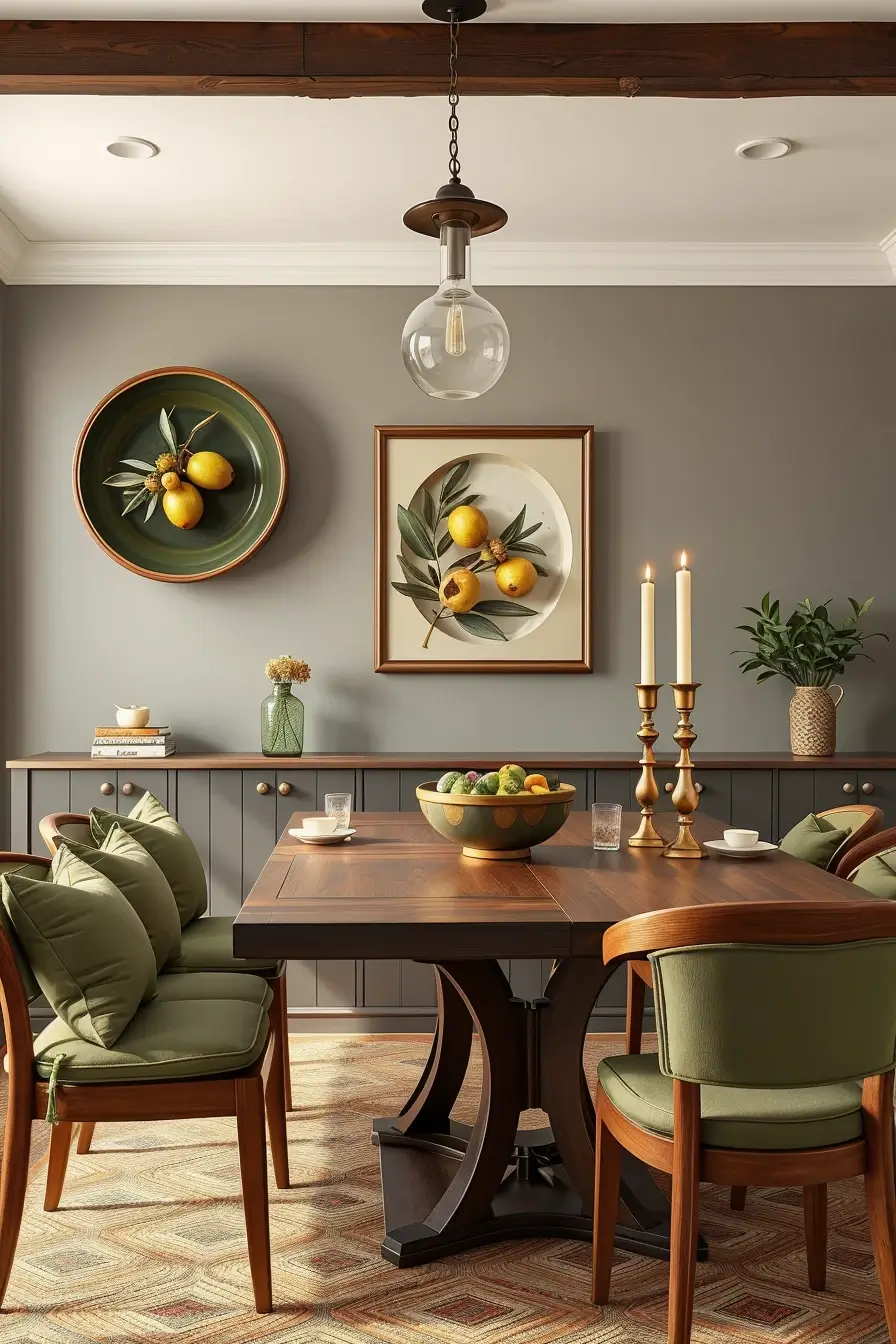
Why do people find late summer decor in the dining room so inviting and unforgettable? How can gentle changes in the texture, brightness and shades show the season ending and autumn beginning? In this article, I will describe different design tips and decorations that capture the atmosphere of late summer. If you’re interested in updating your dining furniture, using different colors throughout the season or using natural materials for your home, this guide provides you with lots of examples and ideas.
Embracing Warm Neutrals in Late Summer Dining Rooms
Late summer makes it easy to stand out by adopting a variety of warm neutrals. Ivory, sand, beige and light taupe remind us of the warm hours of the day as the sun fades away. To me, this style looks exceptional in dining rooms that are meant to be soothing and relaxing. The neutral backdrop matches the soft feeling that arrives after the busy and bright colors of summer.

A soft, neutral color on the walls combined with neutral-colored chairs makes the area look chic and elegant. Add a creamy rug and put a natural wood table on top of it to help create balance. To give your home airiness, choose soft-hued ceramics, roomy vases and sheer curtains. They help create either a current or classic look without being too much for any senses.
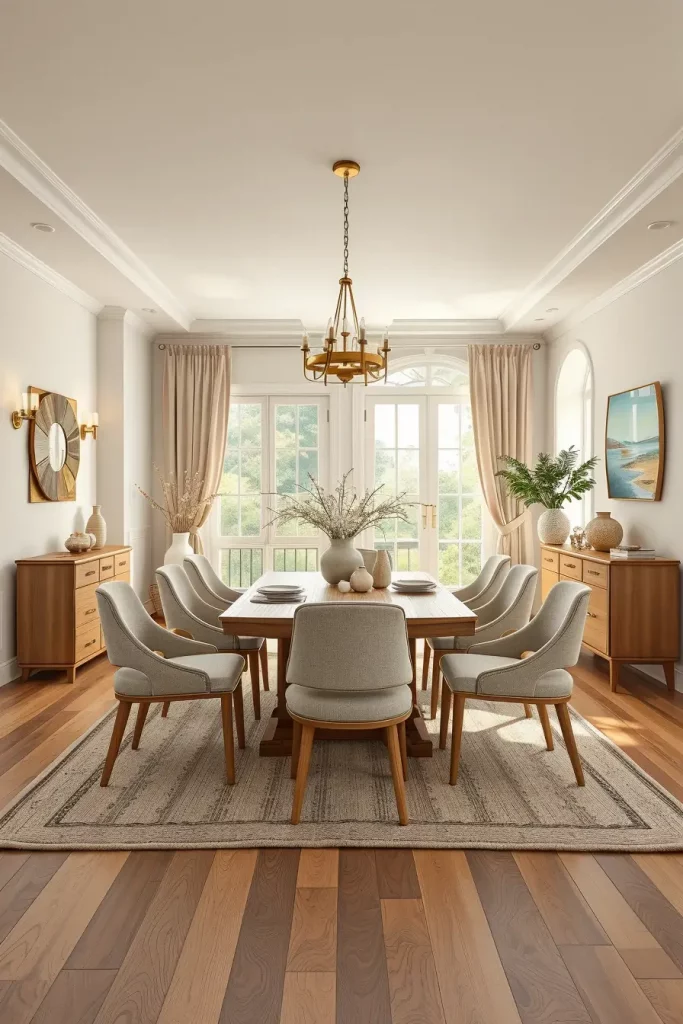
From what I have seen, neutrals can look very interesting when you know how to style them. According to Architectural Digest, warm neutral colors are recommended to make a room soothing for the mind. Yes, when I used ivory and soft oatmeal colors in August, the result was both peaceful and chic without needing to renovate the room.
Adding patterned throw pillows in soft colors or pictures in gold and tan tones would add a more sophisticated touch here.
Using Natural Textures Like Rattan and Linen for Seasonal Charm
Late summer creates a sensory atmosphere in home design and rattan, jute and linen add a lot to this effect. These organic materials reflect nature’s own designs—weathered, woven, imperfect—and bring casual warmth to the dining room. For me, linen runners and rattan chairs are a must during this time since they instantly reflect the spirit of fall.
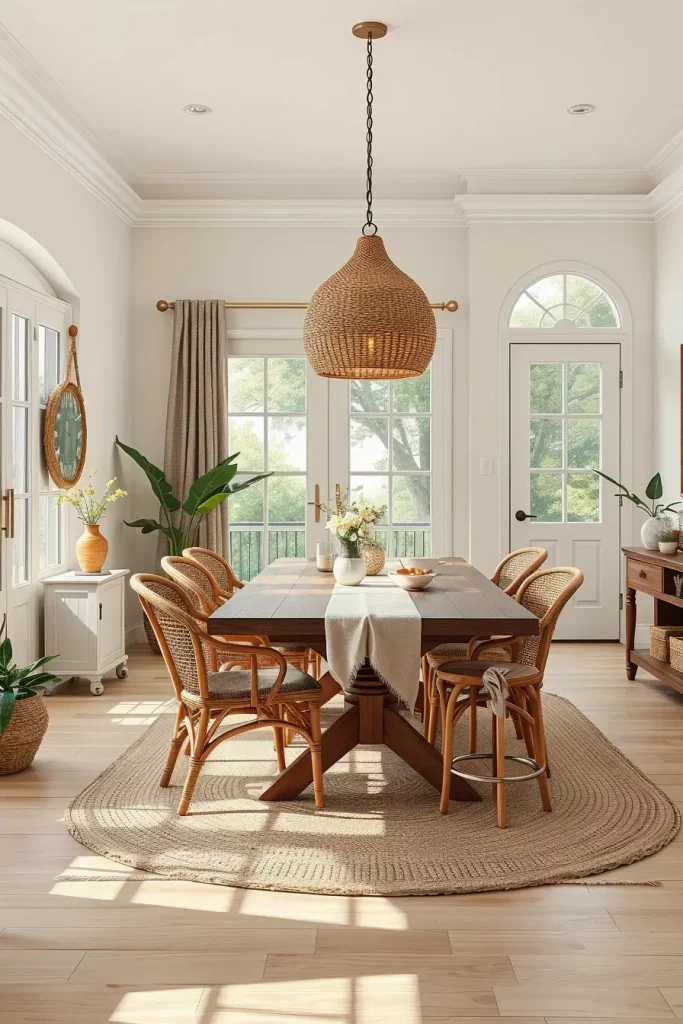
A dangling rattan pendant becomes the main feature above the dining table. Placing light taupe or white linen table runners, napkins and slipcovers on the table gives a cozy feel. Improve the look by placing a jute woven rug below the table. They go wonderfully with wooden dining furniture and all kinds of white or light accessories.

For a stylist, incorporating these materials provides depth in the clothes without spoiling the simple color scheme. A recent article from Better Homes & Gardens showed a dining room decorated with only linen and wicker for the transition from summer to fall—it turned out light, simple and hospitable and I think anyone could do this.
Some baskets with dried grasses inside rattan vases would further enhance the natural atmosphere and make the room more stable.
Soft Gold Accents for a Subtle End-of-Summer Glow
Summer comes to an end and adding gold accents adds a special touch. These elements use the beautiful light of the golden hours and wrap the place in a warm mood without looking flashy. Using soft metallic accents in dining rooms not only enhances the room but still keeps the late summer feeling.

Choose dishes with gold edges, add brushed brass candlesticks and add gold knobs on your cabinets and sideboards. I have a soft spot for using a decorated mirror or wall art with metallic elements since they add lots of sparkle. While these accessories are small, they help to accentuate the decor’s appearance.
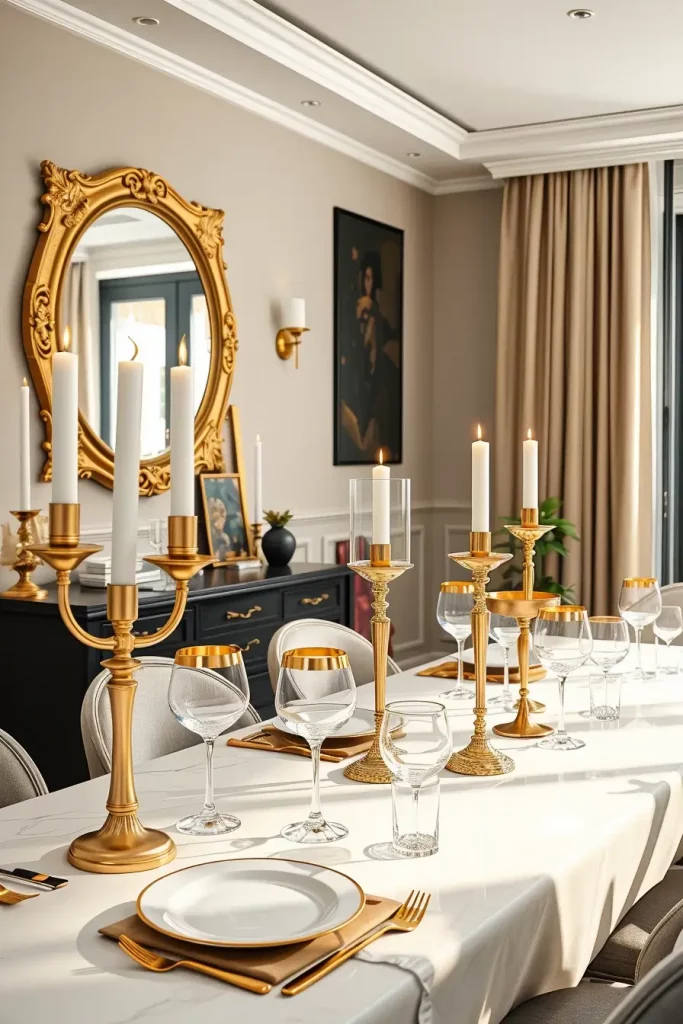
For me, soft golds are nicer than chrome or silver for August makeup, since they seem to catch the sunlight’s weaker rays. According to Elle Decor, you can make your seasonal updates with warm metals and they mention that muted gold “looks luxurious without going overboard.” I entirely agree—it manages to be beautiful and cozy.
Golden arch-textiles such as gold-threaded napkins or an eye-catching runner, could give this look a lovely finish.
Light Wood Dining Tables to Reflect the Season’s Warmth
Selecting a light wood dining table will most likely highlight the natural feeling of warmth found in late summer. Blonde oak, maple or ash details include bright tones and make the room airy. I generally advise choosing light wood finishes for transitional interiors because they look fresh, are versatile and fit well with different aesthetics.
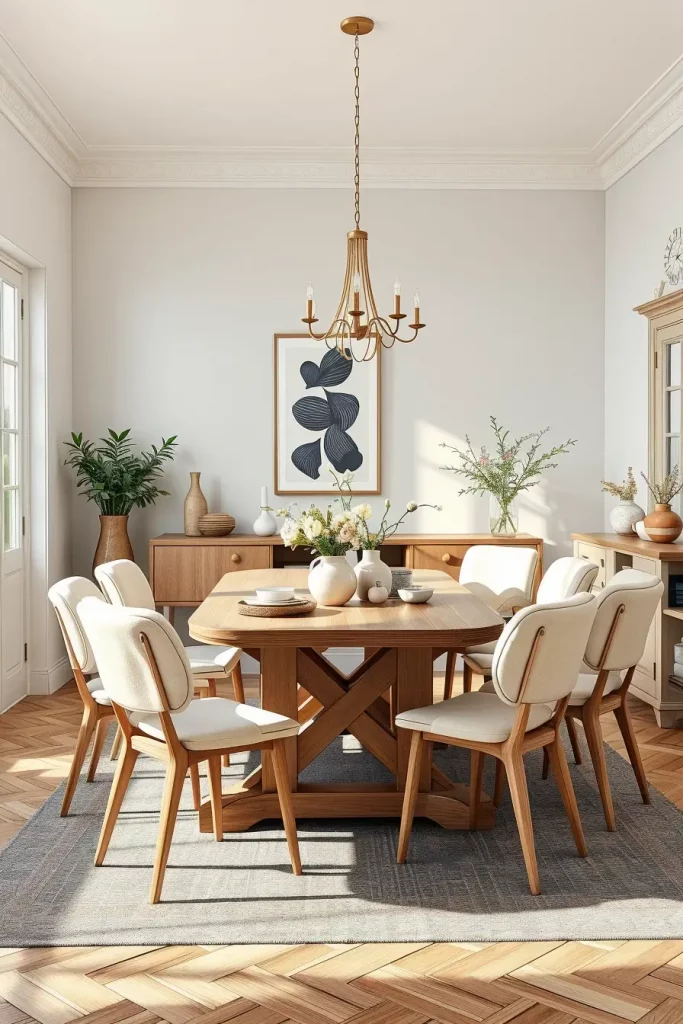
Using a light oak table and cream or white chairs gives a relaxed yet elegant style to your dining space. Using neutral products such as ceramic pitchers, mats or a cotton tablecloth around the table produces a calming effect. Because of the grain, the wood does not have to be painted much or decorated.
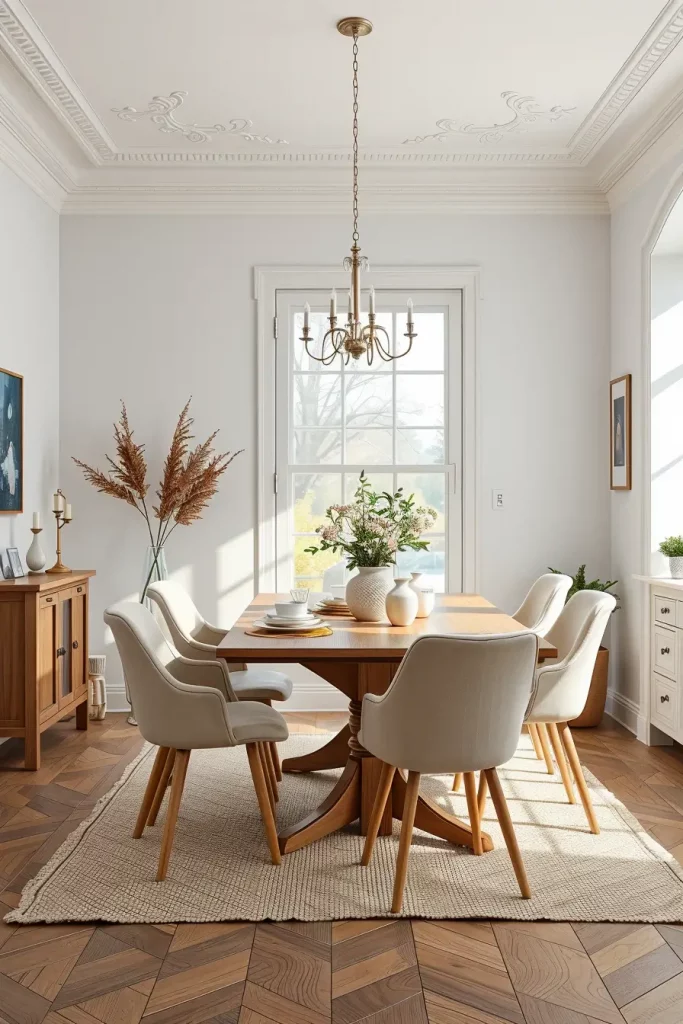
When I think about my experiences, a light wood table seems to attract people and become the center of the room. House Beautiful says that natural materials are constantly popular and tend to look best in open or Scandinavian styles. The style is welcoming, up to date and long-lasting.
Using a matching sideboard or a light-wood shelving unit as a partner would perfectly complete the design.
Late Summer Table Settings with Botanical Prints
Adding botanical prints to table settings brings an energetic, charming and elegant touch. Showing prints with ferns, leaves, flowers or herbs brings to mind beautiful garden evenings and dining outside. For me, plants and flowers bring a boost of energy and help me feel close to nature, indoors as well.
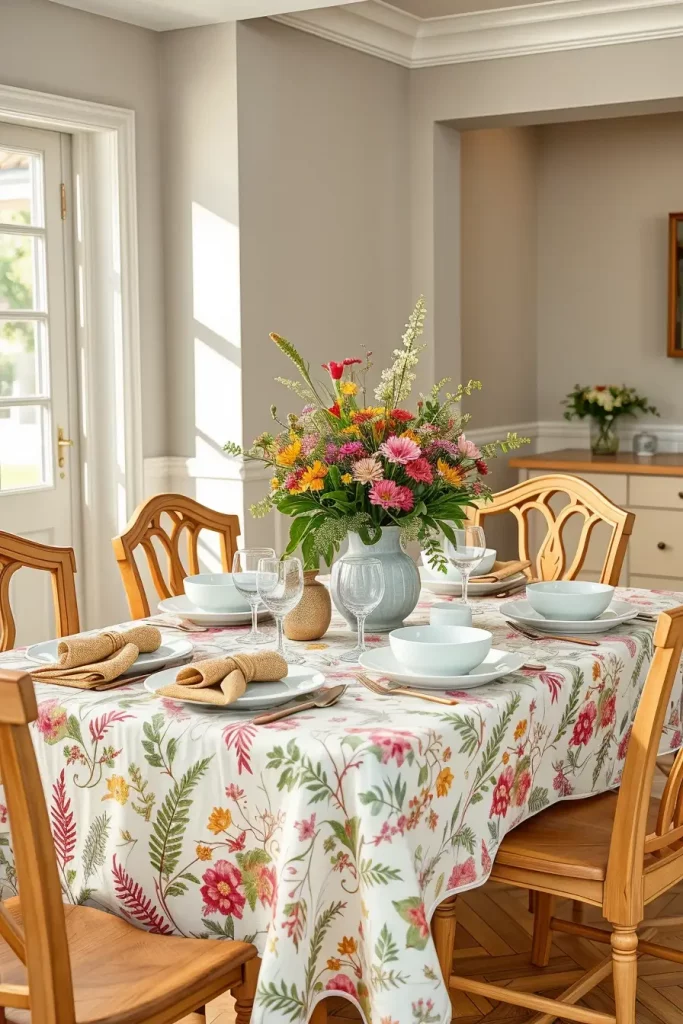
You could use tablecloths, teaspoons and other dishes with soft green, yellow or pink leafy or flowery patterns. They suit neutral and wood-inspired rooms very well. Placing old-fashioned ceramic plates and herb-patterned placemats can give the table a vintage look.

Last year, I did a late summer brunch with fern-patterned napkins and white ceramic dishes which made the event very popular. Many designers, including Emily Henderson, add botanical features to get a stylish yet natural look and this looks great in transitional dining rooms.
To fully bring out the botanical theme, incorporate wildflower bunches or fresh herbs in your table’s centerpiece.
Incorporating Muted Orange and Terracotta Color Schemes
For this season, one palette I love is made of muted orange and terracotta colors. Because of the transition from one season to another, these colors have rich earthy tones and a look of faded sunsets. With soft neutrals or woods, these tones add both excitement and dimension without making the area seem crowded.

Using terracotta, choose accent chairs, ornamental plates or try out a terracotta-decorated wall. The color harmony can be improved by using muted orange napkins, clay vases or a rug in terracotta. Terracotta candle holders or dishes are perfect to get the real Mediterranean feel. The colors blend in with both nature-inspired materials and accessories made of gold.
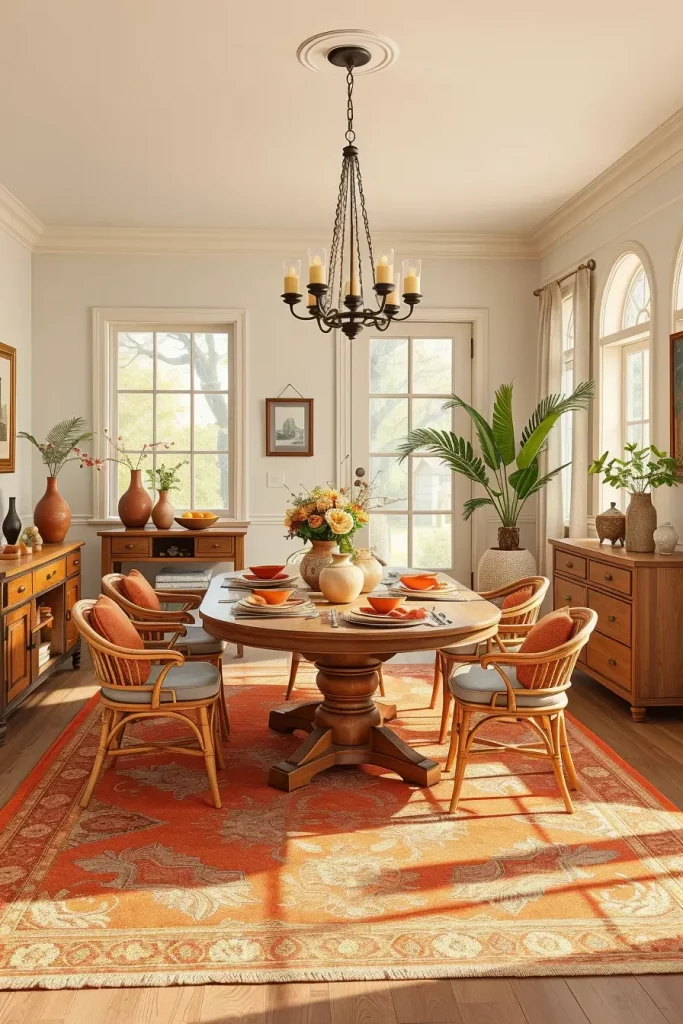
Since multicolored shapes usually need a background, bright oranges can often draw too much attention. The recent issue of Veranda Magazine pointed out that this color palette helps to create a warm feeling as autumn arrives. I think that makes it an excellent way to switch from one season to another.
This could be completed by introducing curtains or drapes in burnt-orange or terracotta to unite the scheme with a soft touch.
Bringing in Olive Green Accents for an Earthy Feel
Using olive green gives your dining space a natural look that suits late summer best. Its light green color, like spring and deeper shade compared to yellows, bring balance for both seasons. For people interested in rich but not extremely dark colors, I promote olive green.
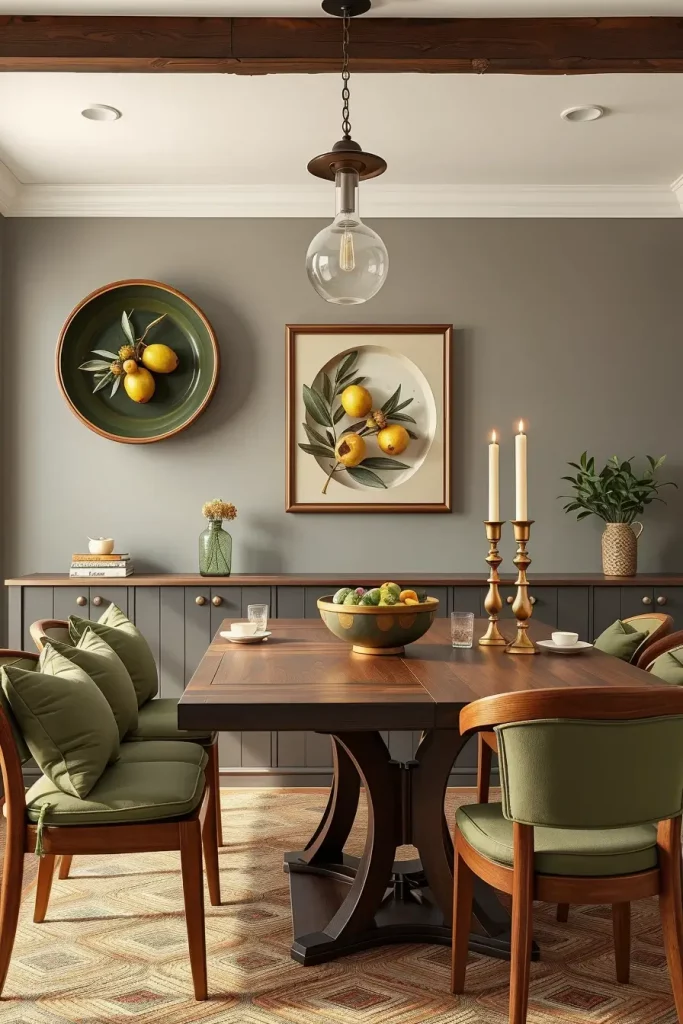
0lives oil color can be introduced in the room through cushion, tableware or paint on trims or furniture. A green bowl, napkins or decorative leaves on the walls will look nice. I love to use olive shades together with white wood and gold, as it comes together in a stylish way that’s not overdone.
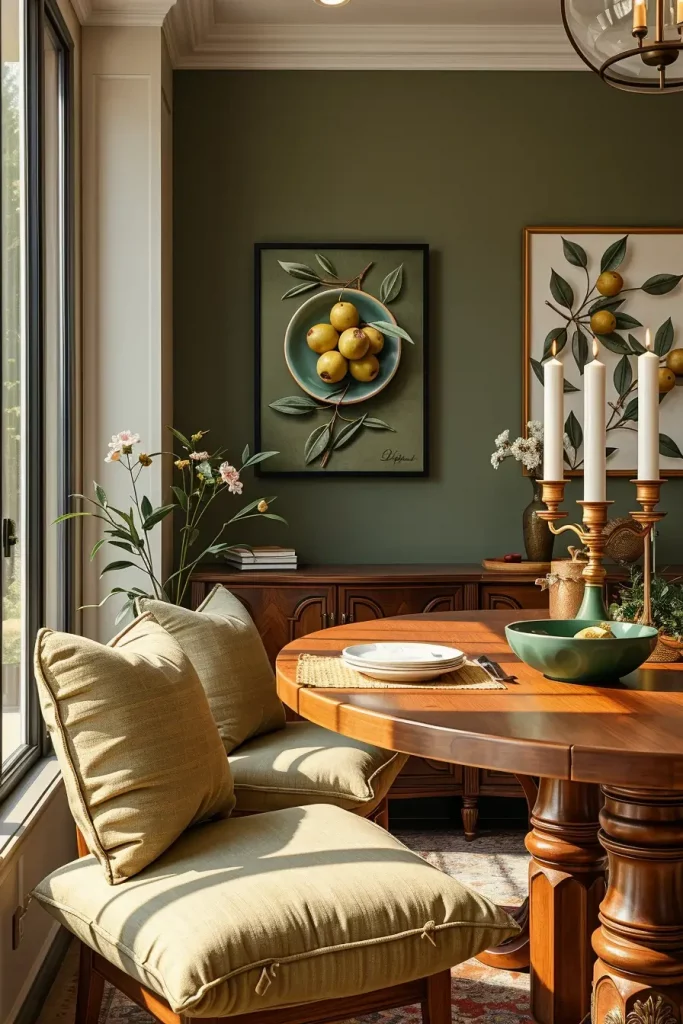
I changed the look of a dining space by adding olive velvet seat cushions and a matching ceramic vase and it added a lot of dimension to the space with minimal heaviness. Domino magazine also writes that olive green gives understated elegance to any room and it shows in many current dining room designs.
A tiny rug in olive or linens with a green border could complete your look and make everything more united.
Late Summer Floral Centerpieces with Wildflowers
Having wildflowers as the centerpiece on your dining room table is one of the easiest ways to enjoy late summer. They are light, natural and beautiful just like autumn itself. I usually pick wildflower bouquets because they are free-flowing, fun and bright, all of which fit perfectly with the relaxed feeling of summer afternoons.
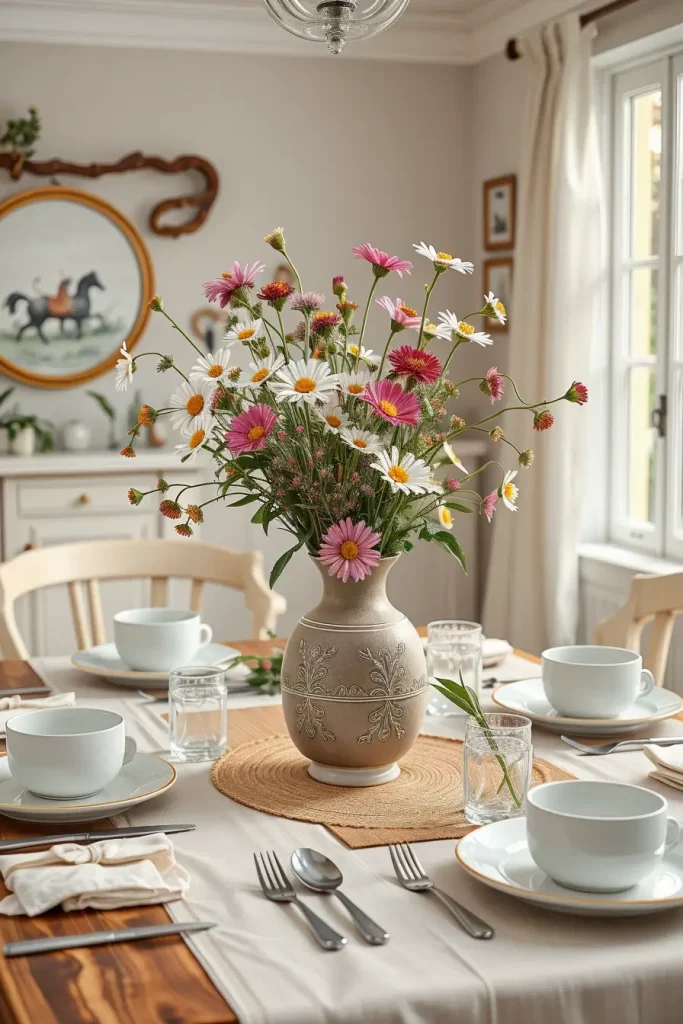
My usual base involves a vase with either ceramic or clear glass, filled with daisies, cosmos, yarrow and sprigs of greenery. They are simple to take care of, moderately priced and make the dining room look stylish. Try putting your candles in mismatched positions for a trendier approach. A centerpiece that is not too high ensures everyone can see well across the dining table, especially when having food.
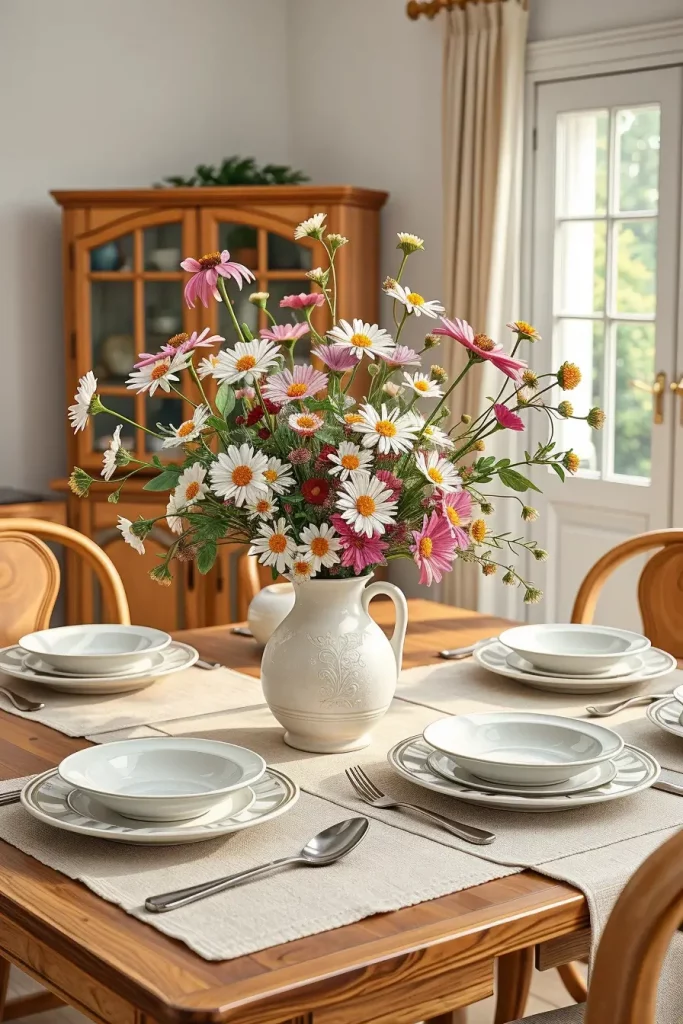
One time, I enjoyed having some wildflowers from the roadside as the main decoration at a simple dinner party and my guests loved it. Martha Stewart Living suggests mixing textures in floral arrangements to create visual interest, and I agree—it’s the subtle details that leave lasting impressions.
Arrange a second vase or smaller bouquet next to one of your windows or display them on a sideboard to have a similar look to your centerpiece.
Open-Shelf Styling with Seasonal Ceramics and Glassware
Using open-shelf style makes the dining room both lovely and practical in late summer, when people prefer moods that are lighter and airier. Putting seasonal ceramics, glassware and bowls on open shelves gives the area a unique touch and function. You can swap things on display since items are more suitable for different seasons.
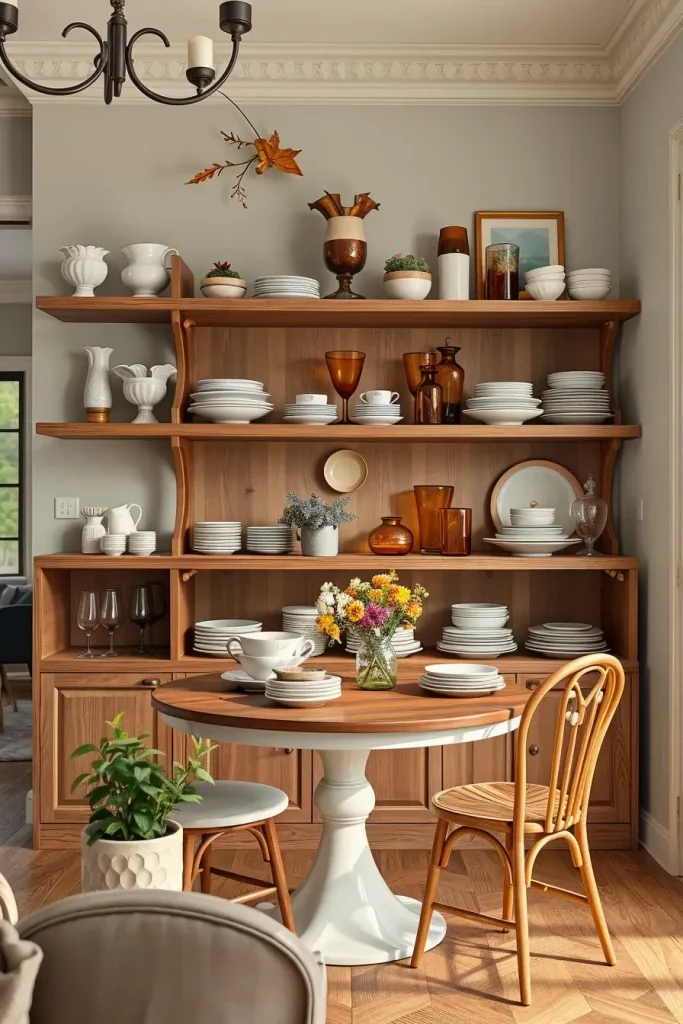
I like pairing with light pottery, old milk-glass pieces or amber glasses which show off the natural light of the season well. To keep the area light and uncluttered, put stacked dishes, bowls and pitchers together with small framed art or potted herbs. Unity can be achieved in a room if you restrict your choices to creams, golds, soft greens or terracotta.
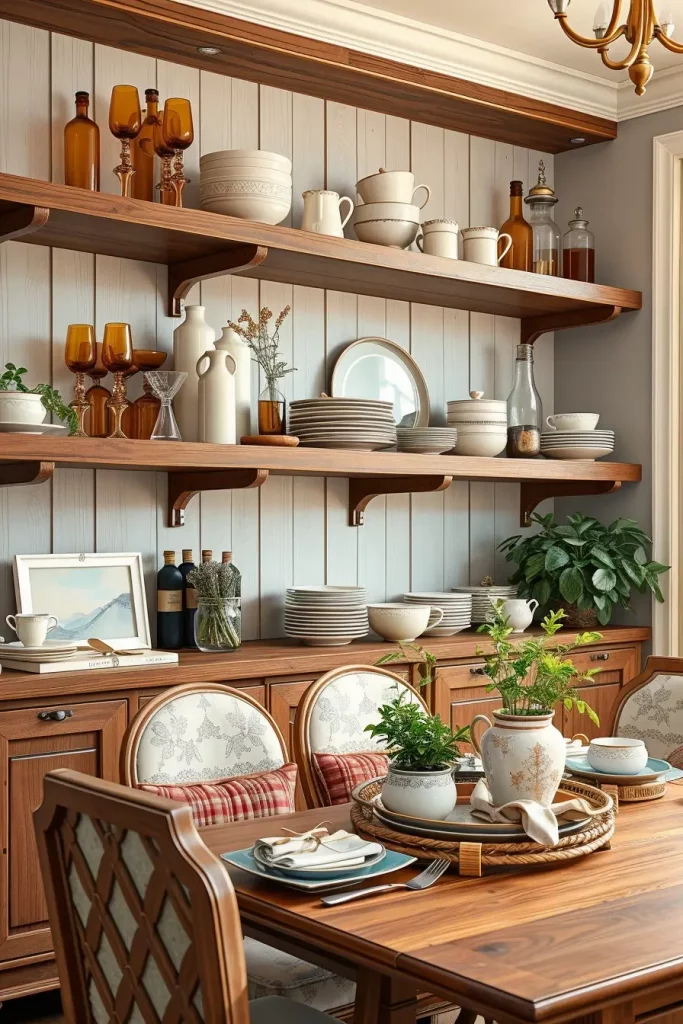
To me, each August is a time to bring in more handcrafted items and products of natural shades as I restock my shelves. Designers at HGTV recommend not making open shelves exactly the same which in my experience makes the room more natural and appealing.
Including small late-summer fruit displays such as bowls of figs or pears, could help bring in freshness and allows you to utilize more of the space.
Layered Table Linens in Cream and Sand Tones
Adding various linens that are warm and sandy colors is a great way to dress up the table for late August. It helps add character and boldness to the design and this looks great even in a narrow dining space. Having cozy lighting works well for me during parties and when making my home comfortable during the day.

First, use a natural linen or cotton neutral tablecloth, then add a runner made from deeper beige or very light cream fabric on top. It works to either let napkins match woven textures or alternatively contrast with them softly by using a light stripe pattern. Try to bring out a comforting mood, but do not make the room feel overly cozy or stuffy.
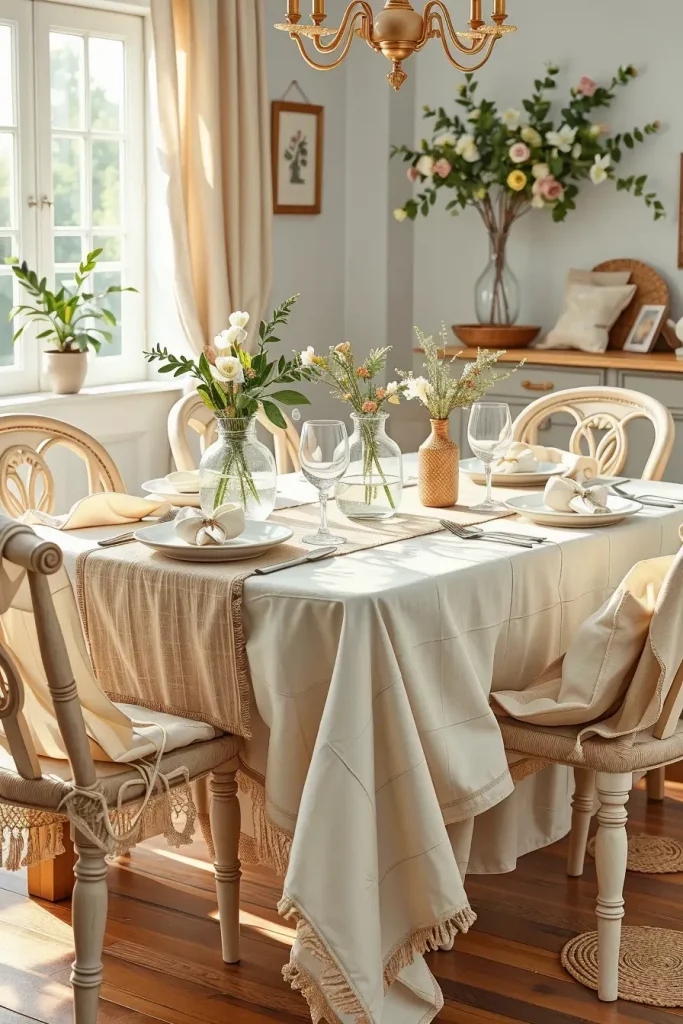
Doing this with fabrics gives a coastal or Mediterranean impression and this style is often encouraged by Southern Living as a way to make our homes feel more relaxed throughout the year. I have realized that these colors add to the beauty of the dishes and the centerpieces during a meal.
Adding little wooden or brass napkin rings will finish the look and make the place table look more elegant while remaining simple.
Woven Chargers and Natural Placemats for a Rustic Touch
I usually highlight the late summer atmosphere in the dining room by using woven chargers and natural placemats. They create different levels and personalities on the table and keep the look light and balanced. They work especially well in transitional months when you’re leaning away from bright summer decor.

You can make your setting Stand out by choosing seagrass, water hyacinth or rattan chargers under white or ceramic plates. Complement the linens and utensils to make the seating area look more unified. You can choose circular or rectangular placemats made from natural fiber, based on your table’s design and what style you prefer.
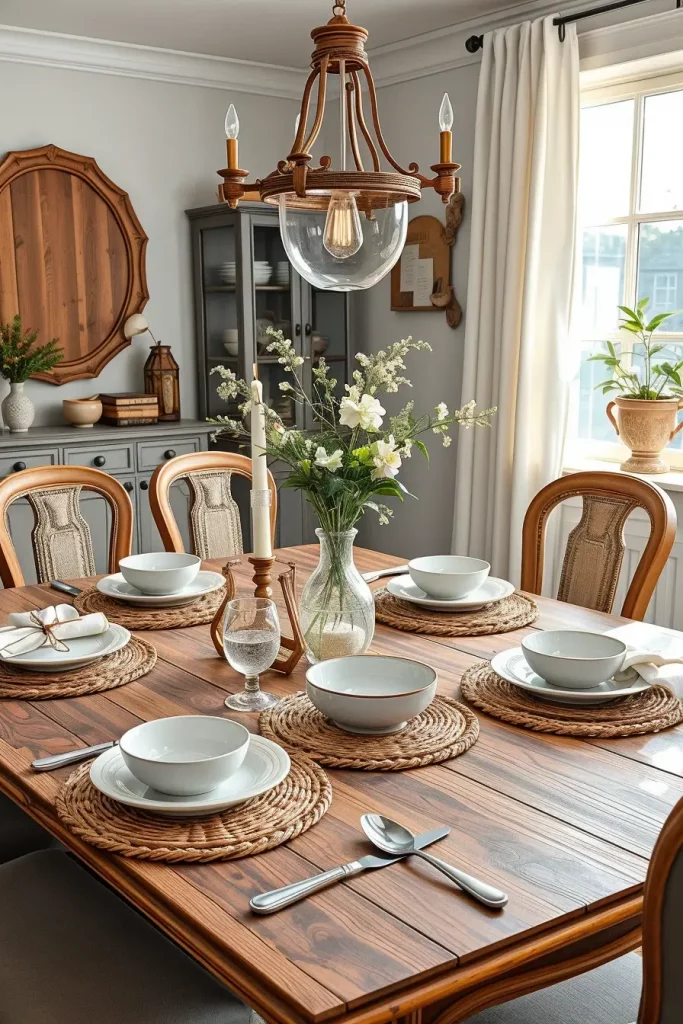
I’ve used these materials in both casual and more refined settings. They point out that you can use woven details to balance the look of any modern dining set. Another thing I like is that glassware is not only attractive but also simple to clean and keep in a small space.
Adding a coordinating woven tray or basket to the sideboard will bring in more texture while giving extra space for placing extra napkins or utensils.
Using Lightweight Curtains for Breezy Natural Light
In late summer, the sun gets softer which is why light curtains are vital to letting in as much natural light as you can in your dining room. Using gauzy, linen or sheer cotton panels gives the room a light and flowing feeling whenever the windows are open.
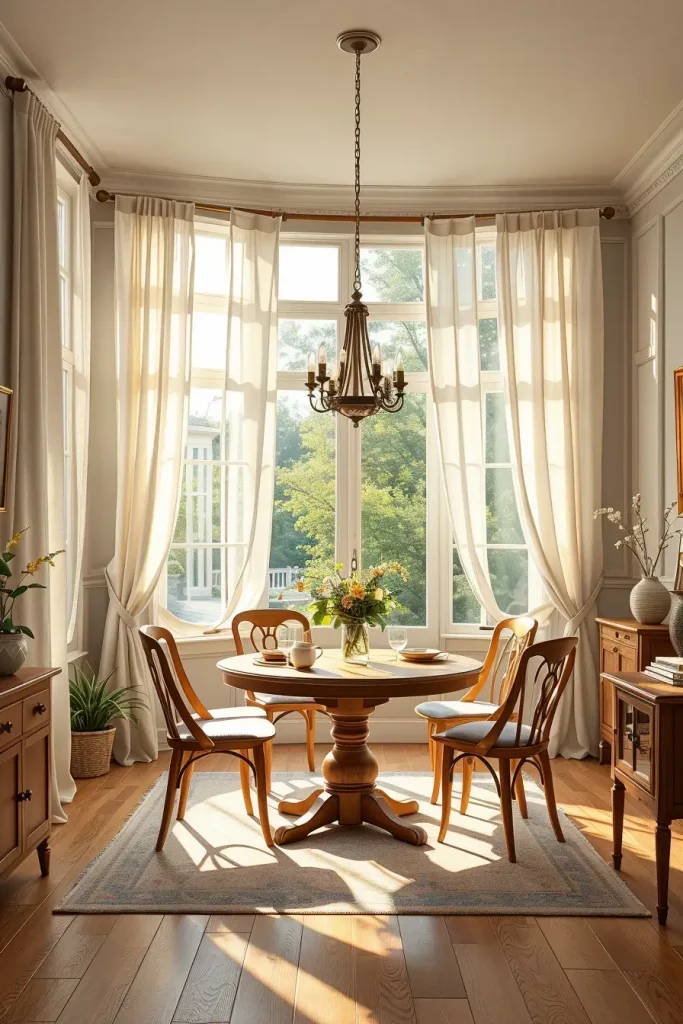
Use white, off-white or beige-colored curtains near windows since they help brighten the room without giving it a dark appearance. Stay away from rich colors or heavy material that might look too fall-like in summer. Brushed gold or black iron rods can give a hint of contrast and coordinate with other items in the room, for example, mirrors and wall sconces.
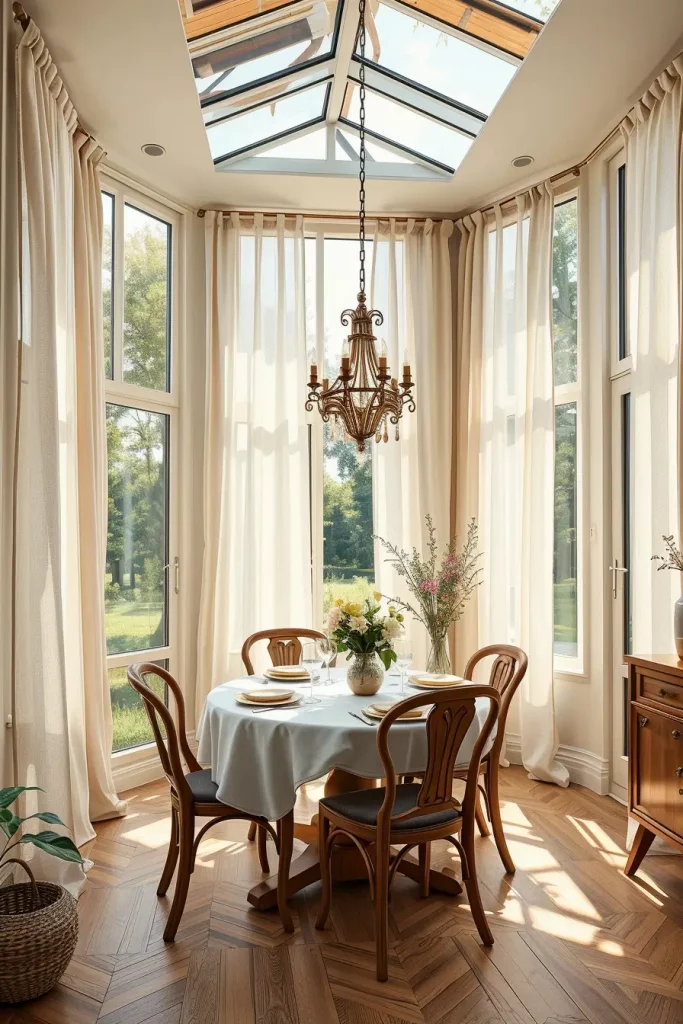
I have found out that using light curtains makes the dining area look welcoming during lunch and shining with a beautiful glow at night. Apartment Therapy usually recommends lighter curtains for the dining area in the summer, since light and windows are important there.
If you want to make the setup better, try adding jute or linen tie-backs or even attractive curtain clips in gold or wood colors for a more autumnal look.
Statement Lighting with Wicker or Wood Fixtures
The atmosphere of a dining room depends on the lighting and I advise using wicker or wood light fixtures as main features in the late summer. These decorations make the room feel rustic and bring some textures, but the overall mood is easy and pleasant. They look outstanding together with other natural materials and autumn colors.
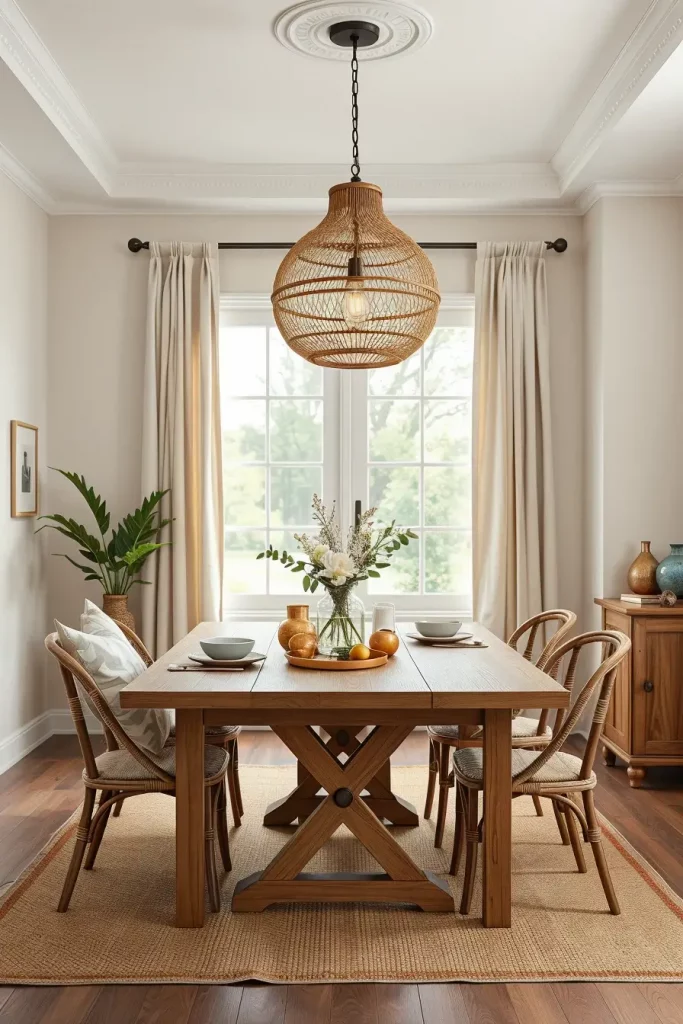
Choose pendant lights that feature weaved bamboo shades or beautiful hanging chandeliers using wooden beads. Add them to a light wood dining table for consistency in the room. Keep bulbs warm (2700–3000K) to create that soft, golden glow that echoes the end-of-summer light. Go for natural-looking materials instead of shiny or highly industrial ones as you want an earthy touch.
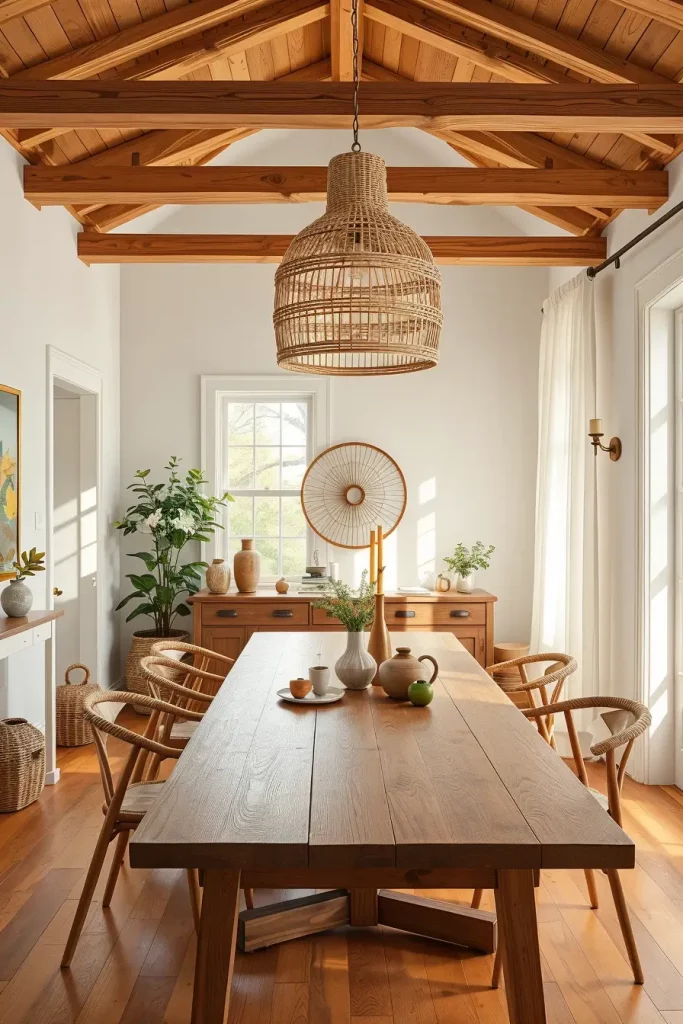
Making this swap by replacing the metal piece with a woven rattan pendant made the whole room seem different. The magazine recommends choosing natural lamps that give off a warm glow like sunset when it’s autumn. Even with no lights, the texture of wicker gives the space another fascinating look.
For this area, choose lights that are the same in style or have a similar vibe and set them up to illuminate the room and maintain the overall theme you have chosen.
Late Summer Fruit Bowls as Edible Decor
Putting some of your favorite fruits in a bowl is a very easy way to decorate your dining room for late summer. Specifically, they bring excitement and comfort and turn the room into a functional place to be. It’s such a nice touch to put a bowl full of figs, peaches or grapes somewhere at the dining table or buffet.
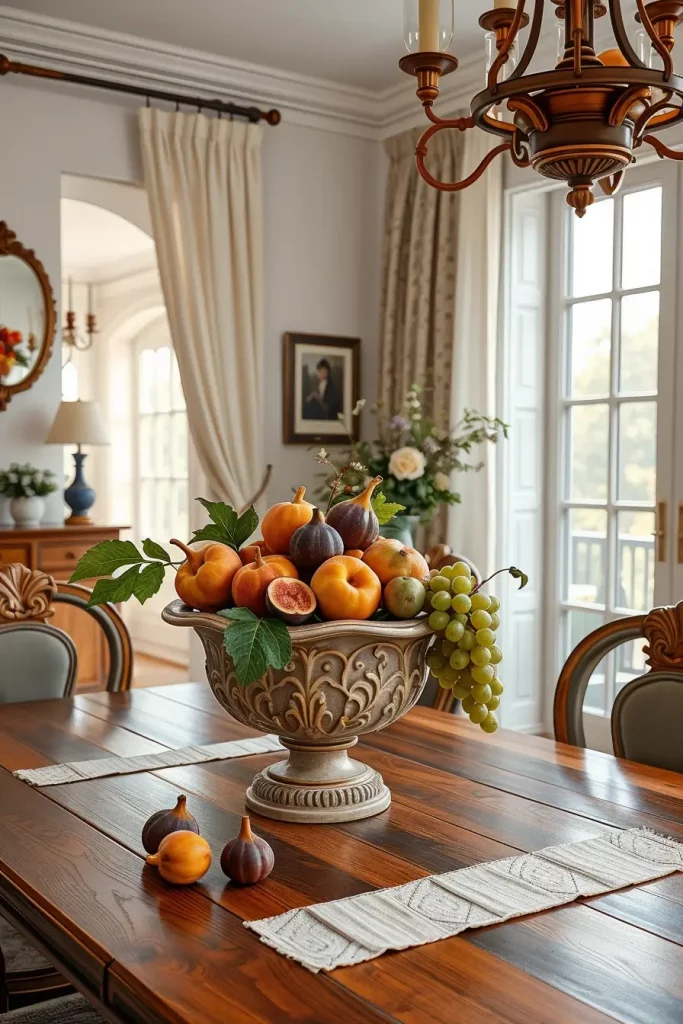
Pick ceramic, stone or wooden bowls in shades similar to nature to bring out the late summer colors. You could use fruits such as green pears, purple plums or a bunch of lemons to serve as your centerpieces from season to season. As required, move the fruit around to keep it looking and tasting great.

From what I know, homemade displays receive more compliments than anything from the shop. Bon Appétit maintains that adding dishes or food to interiors adds space without asking too much.
If you’d like, put a weaved tray below the bowl and set some linen napkins next to it on the sideboard for a balanced look.
Wall Art Featuring Harvest and Botanical Themes
The first thing that comes to mind about late summer is natural textures and warm shades. That is why adding wall art that celebrates harvest and botanical themes is great. To make a peaceful and seasonal mood, I usually put up framed prints or canvas panels with soft watercolors or pressed botanical specimens. You can welcome nature easily to your dining area without making everything appear too much.
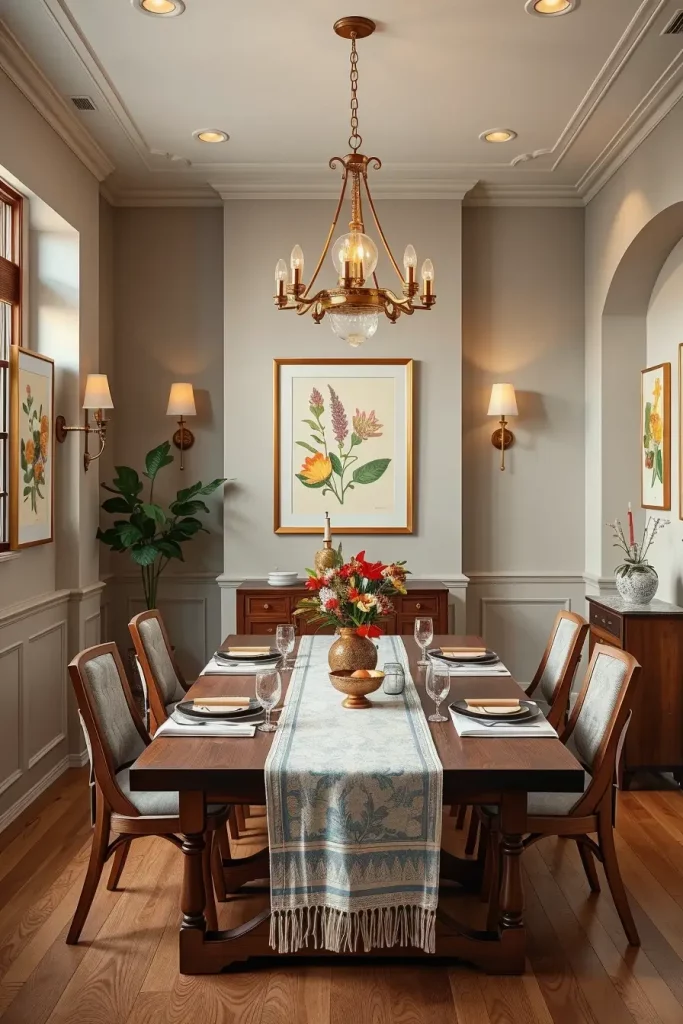
To make a space look more light, I usually combine wheat, eucalyptus and wildflower motifs with soft white or wooden frames in my projects. Putting an upholstered sofa above a buffet or on the main accent wall brings out its best features. If your dining room is on the bigger side, arrange prints and mirrors on the walls to make it more eye-catching.
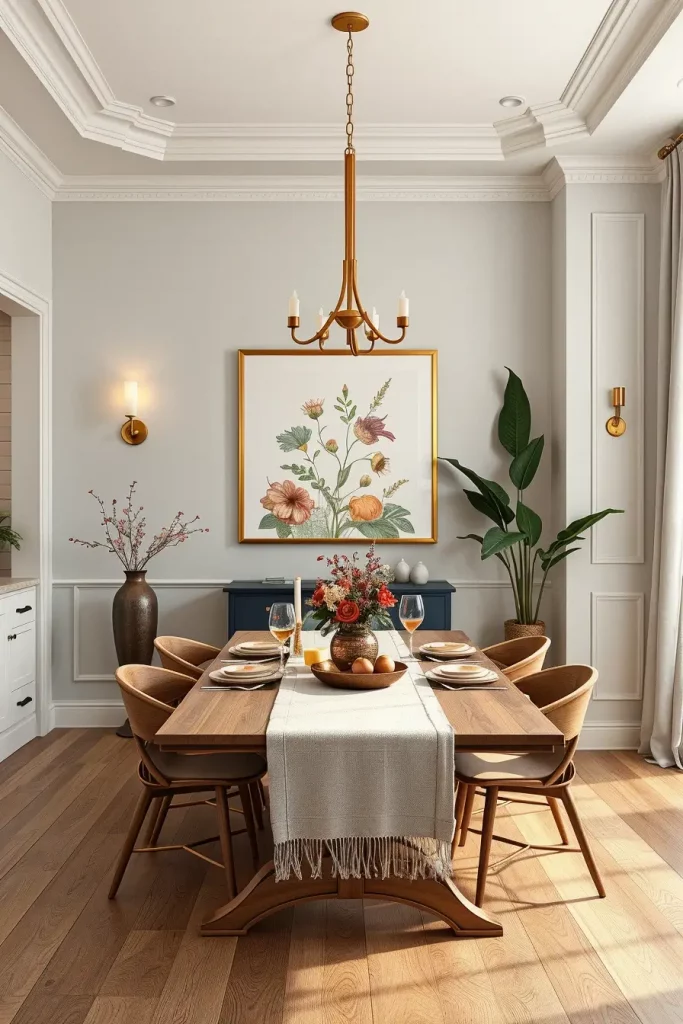
From what I’ve noticed, hanging art is a simple way to make a room feel appropriate for the current season. Elle Decor says that by changing your art according to the seasons, you can easily update your interior without expensive renovations. The same thing happens in this case: a few excellent pieces can give your dining space a modern touch.
A perfect ending to the setup is by placing sconces on the wall that have a brass or matte black finish. The display will improve how the art is seen and the warm lights will brighten up the room at night.
Mixing Vintage and Modern for a Transitional Look
I really love the transitional look and it works particularly well for summer decor. It mixes modern touches with nostalgia and this works perfectly for this change of seasons. I begin by choosing a traditional piece, for example a mid-century sideboard or antique farmhouse table and then add modern, simple items from there.
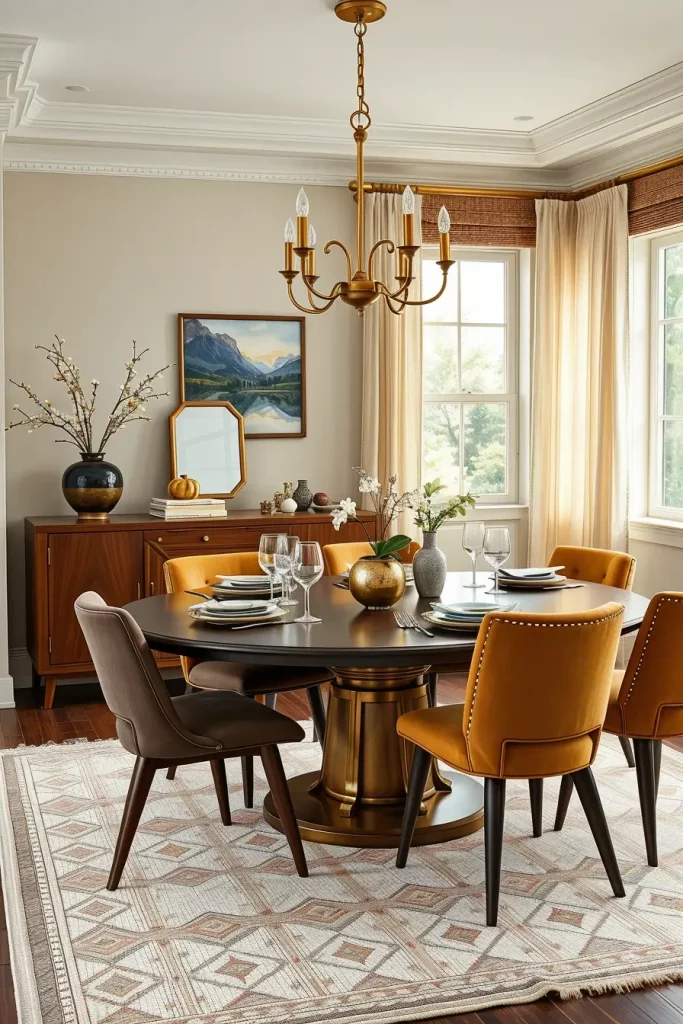
Most of the time, I choose to mix globe pendants and minimalist chandeliers with vintage-style dining chairs. Placing textured runners, brass-colored utensils and big mirrors can connect the different styles. The clean print on the rug connects all the different items.
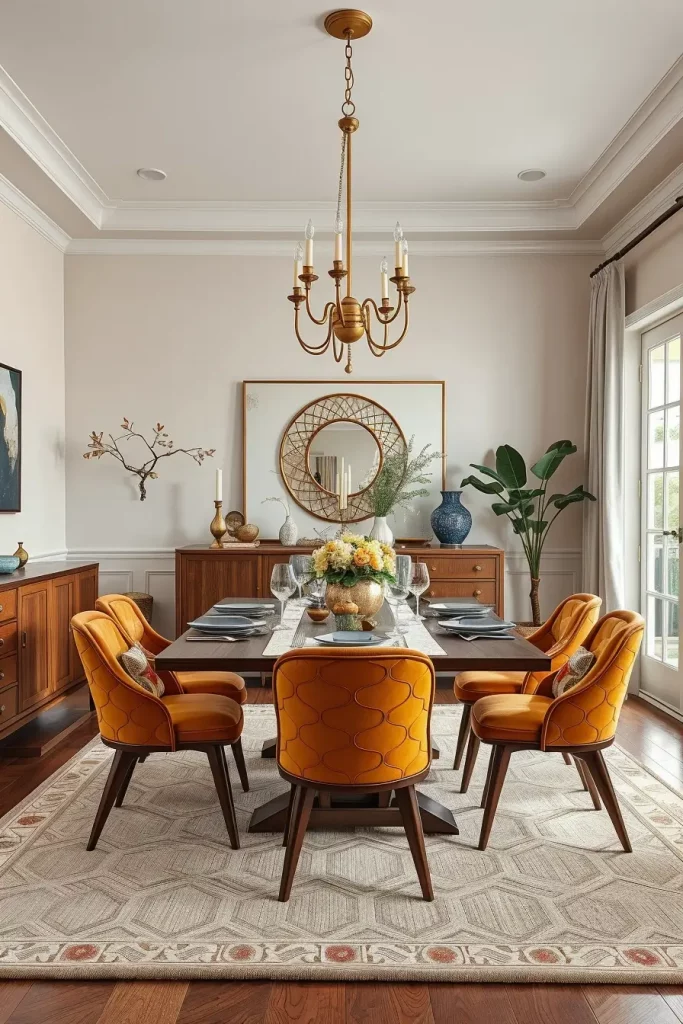
I feel that homeowners can display their traditions when decorating with this blend. According to Architectural Digest, bringing together different style elements can make a room more fascinating than using just one theme.
For a more impressive look, put a few cushions in velvet or linen, preferably in a deep mustard or navy color, to signal autumn, but keep the design relaxed.
Coastal-Inspired Dining Room Details for Late Summer
Coastal touches around the room can introduce a sense of breeze inside your house, even if you’re far from the ocean. Using driftwood patterns, sandy beige linens and marine blue colors keeps the feel of the space bright and suited for the season. Decorating with coast-styled elements is best in late summer, as it brings to mind summer at the beach mixed with the calm days of fall.
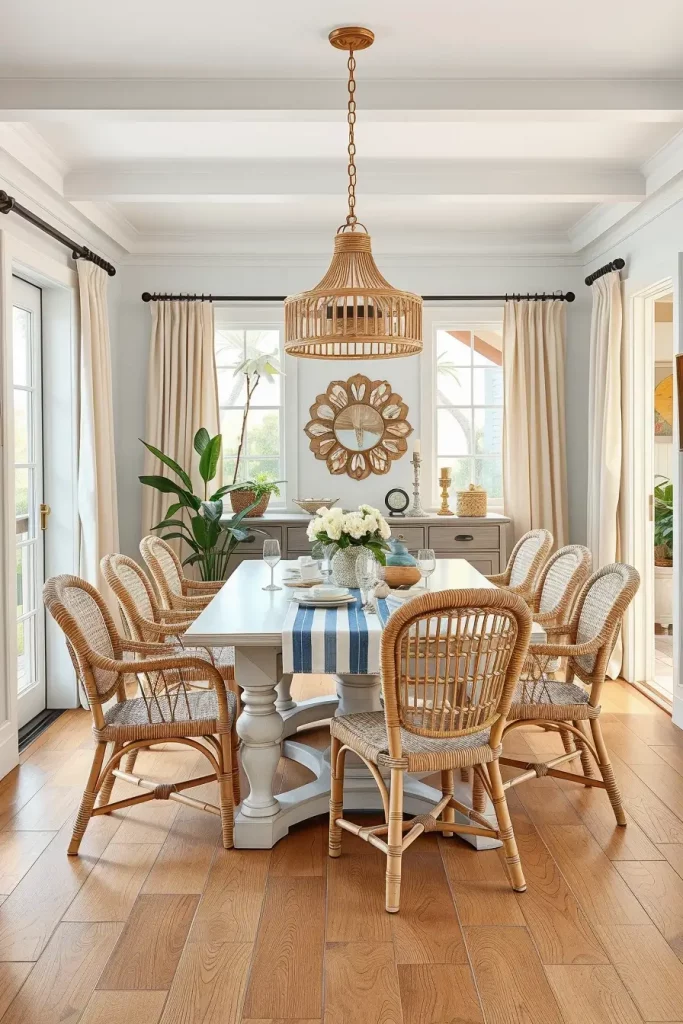
A perfect combination is a light-washed wood table and chairs made from rattan. Add a double blue and white rug to your living area and add in ceramic vases, coral pieces or shell bowls as decorations. Place gauzy curtains on the windows for diffused light and add seagrass pendants to add an interesting centerpiece near the ceiling.

In my view, this theme is very mellow and simple to enjoy. Better Homes & Gardens points out that incorporating coastal design has an instant opening and brightening effect on any area. A great example is dining rooms which should have good airflow and lots of natural light.
Coastal maps from days gone by or easy nautical wall art will add a special touch and prevent the style from looking cheesy.
Light Blue and Sage Palette to Cool Down the Space
Even in late summer, it may feel hot and I like to use certain colors in my designs to make a room seem cooler. The mix of light blue and sage is refreshing, pleasant and appropriate for this time of year. Mixing these greens gives a livable sense of lightness, neither cool nor cold because of the lovely blue undertones.
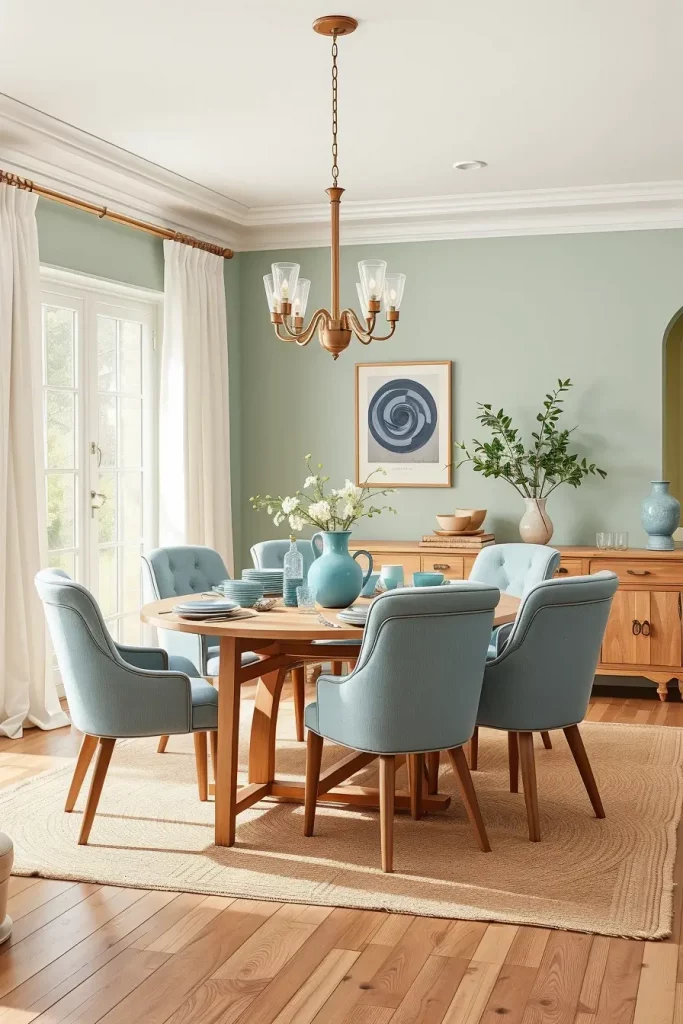
My style is to have light sage or celadon green walls and pale blue dining chair seats or drapes. Lay a blue geometric pattern rug and top the shelves with ceramics that match the blue tones as a little extra style.

The experts also like this color combination. House Beautiful suggests that a combination of soft greens and blues in a room promotes peace and is ideal when you want to relax. The ambiance suits dining rooms well, especially when the evenings are very warm and it’s dark outside.
To avoid making your home feel too sterile, add some jute, oak or linen elements to soothe the cool design.
Seasonal Candle Arrangements with Citrus or Herbal Scents
It’s easy to create a seasonal look in the dining room by adding candles and when it’s late summer, I look for ones with citrus or herbal fragrances. To keep that summer mood going but also get ready for autumn, use lemongrass, basil and orange blossom.

Most often, I arrange a table centerpiece by placing multiple candles in glass holders. Placing rosemary and mint sprigs near the center and putting the plants on a wood or ceramic tray will support the structure. I think it makes the meal appear and smell nicer.
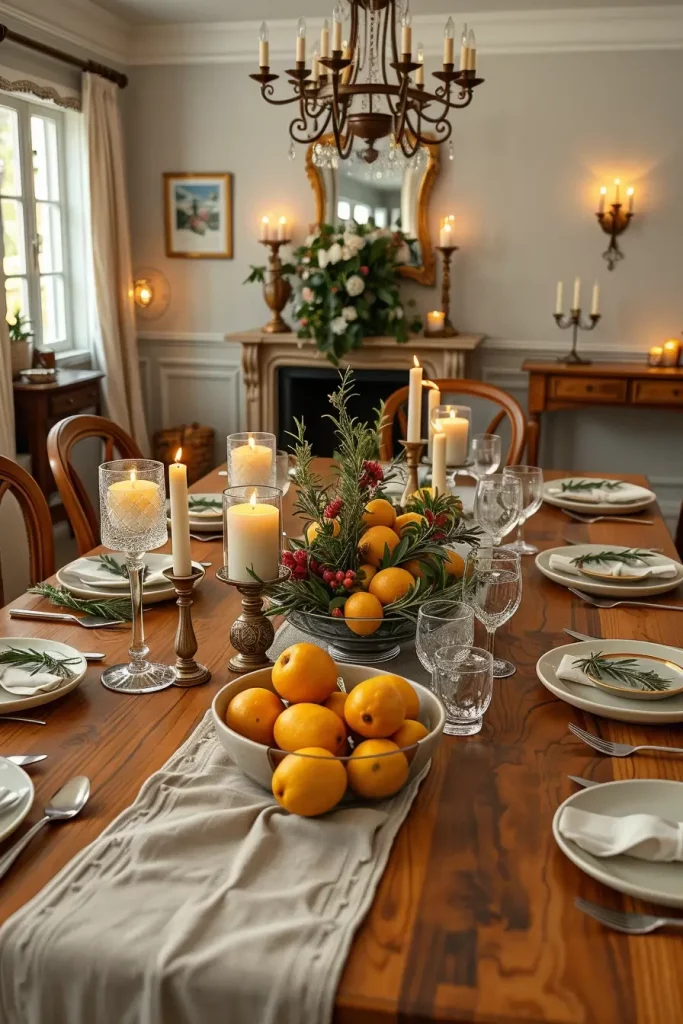
If I am having dinner early evening, I enjoy lighting candles since they produce a soft warmth and create a pleasant atmosphere. It’s a good idea to change the fragrances in your home with each season, as Martha Stewart Living advises, according to me.
End the setup by grouping lemons or limes with candles in a shallow bowl, as this addition will look lovely and sound great when the candles are lit.
Creating a Relaxed Atmosphere with Open Dining Layouts
Late summer parties benefit a lot from having an open dining area. Since they connect to living or kitchen spaces, guests can always feel welcome to move around. In summer, when spending time with family is popular, open layouts work great because they are both practical and pretty.
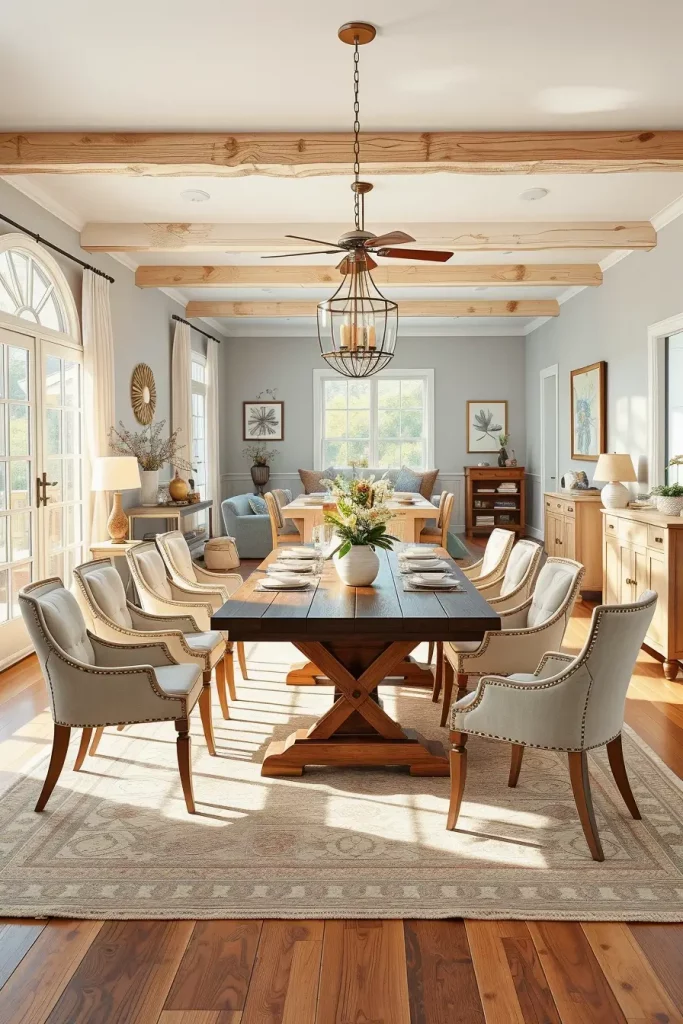
A big rug often helps to define the dining area for me and I use a pendant light to give the area a focused look with open views. There is an inviting atmosphere around a big wooden table set with white or light chairs. Airy materials such as cotton or linen in the forms of cushions or tablecloths add to the relaxed feel of a room.
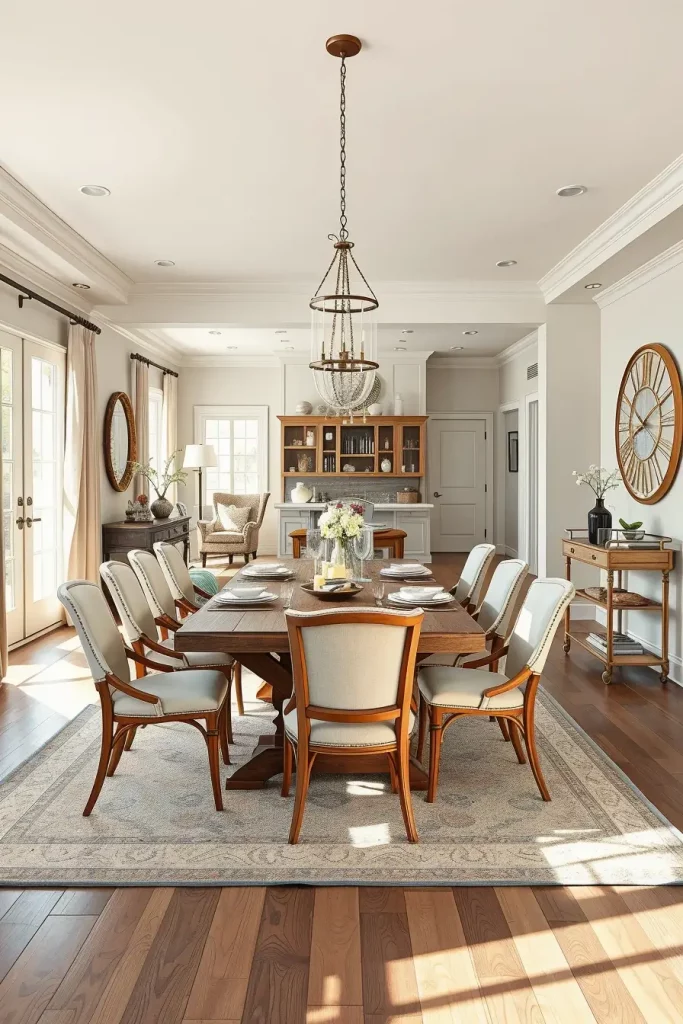
I have found that my clients love this arrangement since it fits nearly all types of events. Many articles in Dwell magazine explain that creating such open areas makes it easier to enjoy and connect during summer months.
Add a built-in such as a bar cart or console to keep up the ambiance and help you store your things tidily.
Glass Vases with Tall Grasses or Branches as Centerpieces
It is very simple and eye-catching to put tall grasses or branches in large glass vases in the dining room. It looks simple, natural and very sophisticated. I choose this set-up when I want to say something easily, without making things too complex.
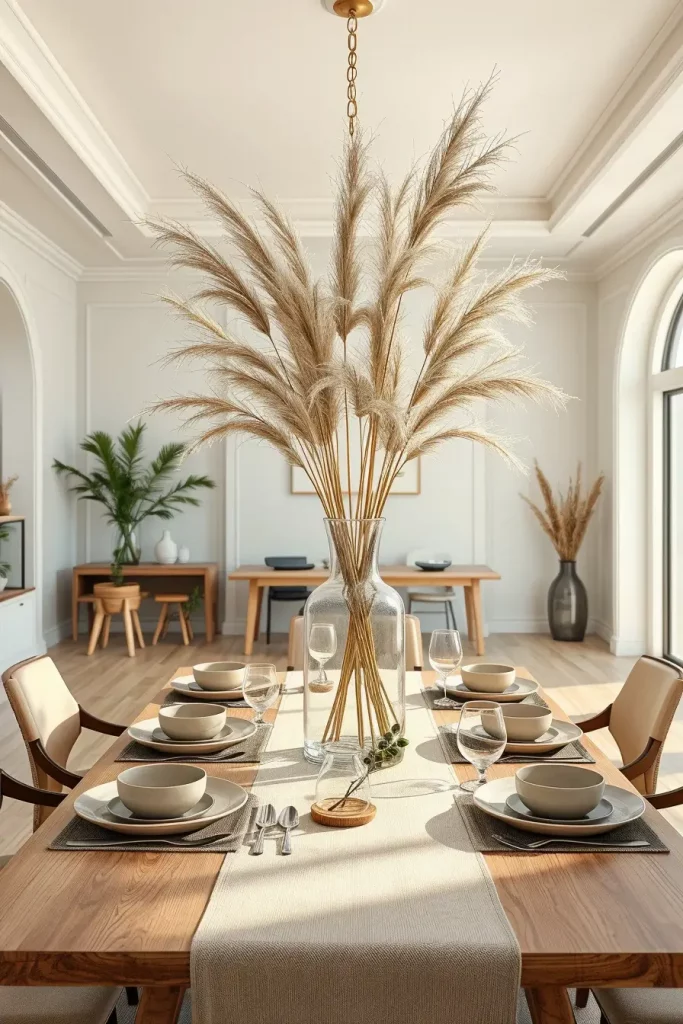
Pampas grass, dried wheat and olive branches are among my favorite selections. The arrangement goes into a see-through jug vase and is set directly in the middle of the table. With their height, tall items can make rooms with high or vaulted ceilings more interesting visually.
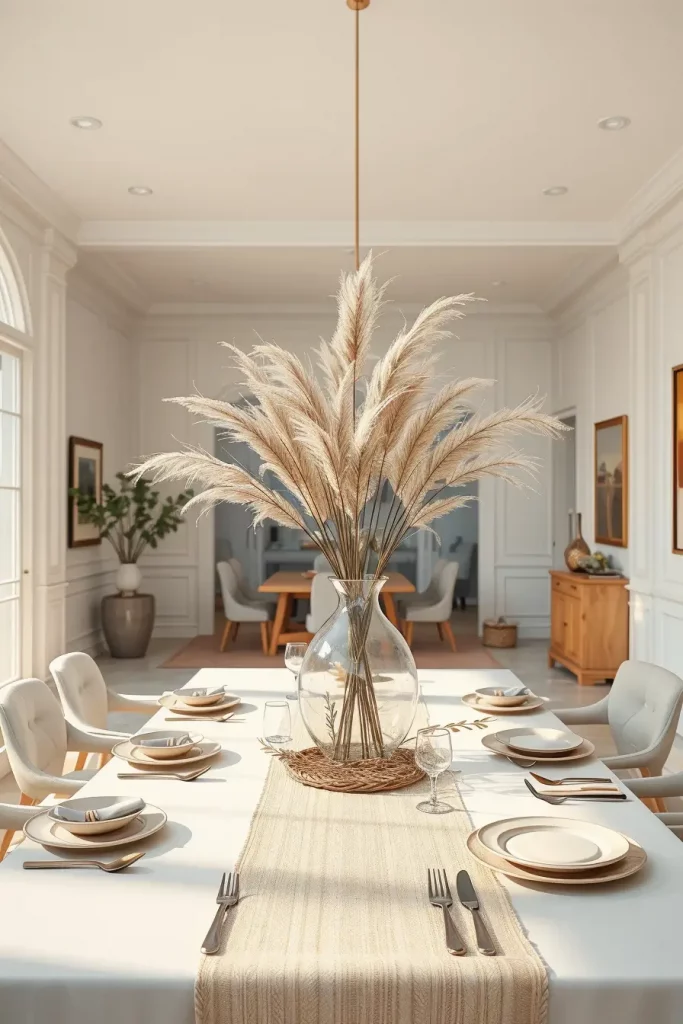
A lot of clients find themselves amazed at how much this can change their home. Because of their bulk, big botanical decor is striking and suitable for any budget or house space, says Real Simple.
The rest of the table should be kept simple to finish the design. The centerpiece is made more noticeable by using neutral placemats, a pale runner and earthy-colored pottery.
Outdoor-Inspired Dining Spaces with French Doors
Bringing in lots of late summer sunlight is possible when you insert French doors near a dining room that opens up to a patio or garden. This design lets light in, helps the diner feel part of nature and makes dining seem more natural and special. It turns into a place where privacy and openness mix which is suitable for a new season.
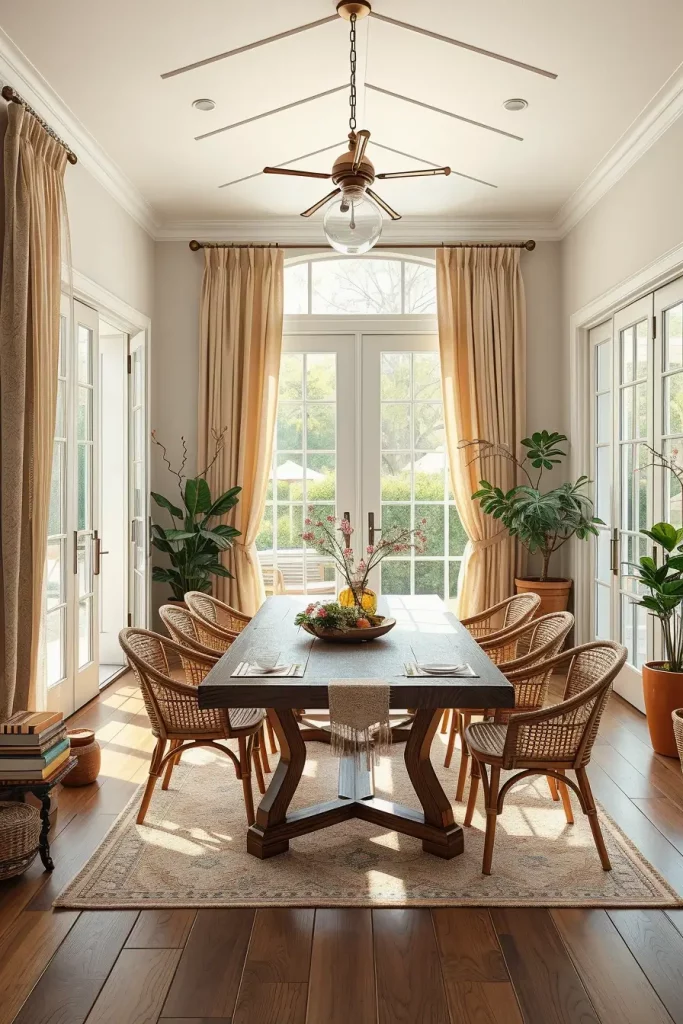
In most cases, my process starts with glass French doors and is completed with natural materials such as a reclaimed wood table and woven furniture. Putting up lightweight white or beige curtains adds a cheerful and soft atmosphere in the room. Potted plants and terracotta planters make the indoor decor go well with the outside views for an uninterrupted flow.
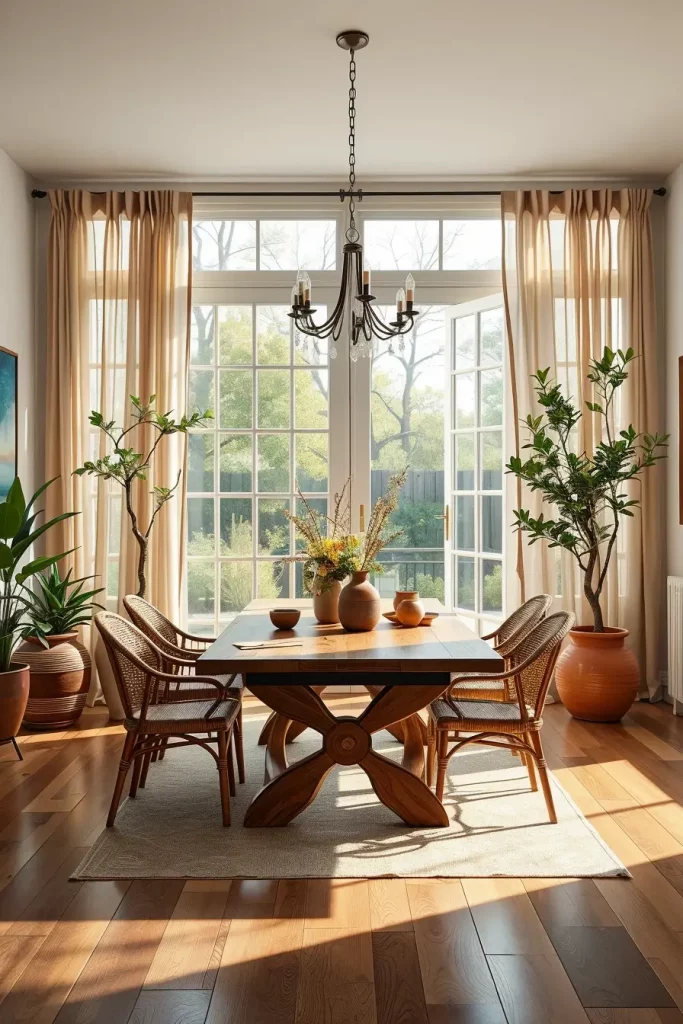
At home, I have seen that the layout makes us dine outside more and facilitates easy entertaining. According to Veranda magazine, making the difference between the inside and the outside less obvious is one of the best approaches to year-round design.
Including a big indoor tree, for instance a fiddle-leaf fig, will add more detail and show the change between the indoors and outdoors. As a result, the area looks finished and full of energy.
Tableware Inspired by Summer Landscapes
Many people may overlook it, yet tableware is very important when setting up for late summer dining. I am encouraged by scenes from summertime: terracotta, seafoam blue, sandy beige and green leaves. Such colors help create a soothing atmosphere, even without using obvious seasonal images.

My taste goes toward using hand-glazed ceramic plates in earthy shades with flatware in matte gold and napkins that are either warm white or muted rust. Giving the glasses a hint of amber or green color helps add to the atmosphere. Woven or stone trivets make it possible to feel the natural environment.
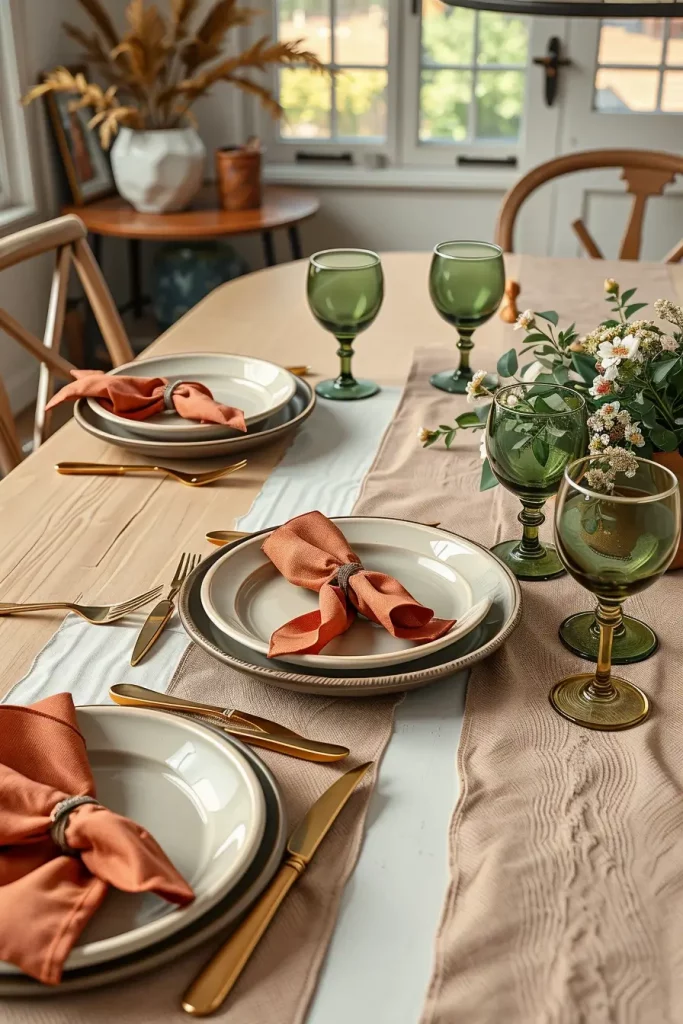
My experience shows that creative tableware works best when there’s a general idea rather than a direct connection with the theme. Domino magazine makes the point that organic materials and earth tones give seasonal tables a sense of unity and I think this is excellent.
Sometimes, I place different types of materials such as linen, ceramic and glass, together on a table to build deeper appeal and harmony. This tiny detail leaves a big impression.
Incorporating Earth-Toned Upholstery in Dining Chairs
Earth-colored upholstery in dining rooms keeps the area warm and inviting during late summer. A lot of the time, I suggest choosing seat or cushion covers in shades of burnt sienna, terracotta, ochre or muted clay. They change the color scheme according to the season and move the space into autumn gradually.
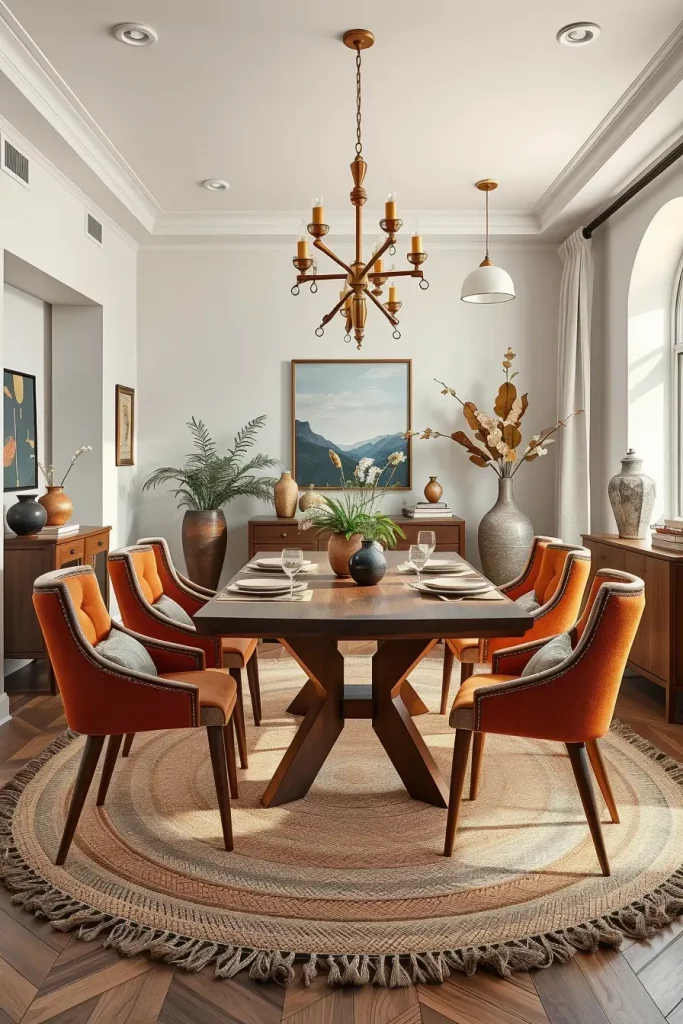
Most recently, I changed the upholstery of mid-century dining chairs to a deep camel-colored linen. Adding a walnut table and a natural rug brought warmth and made the room appear just right for fall. A fabric that bubbles or a choice of piping can dress up a minimalist environment.
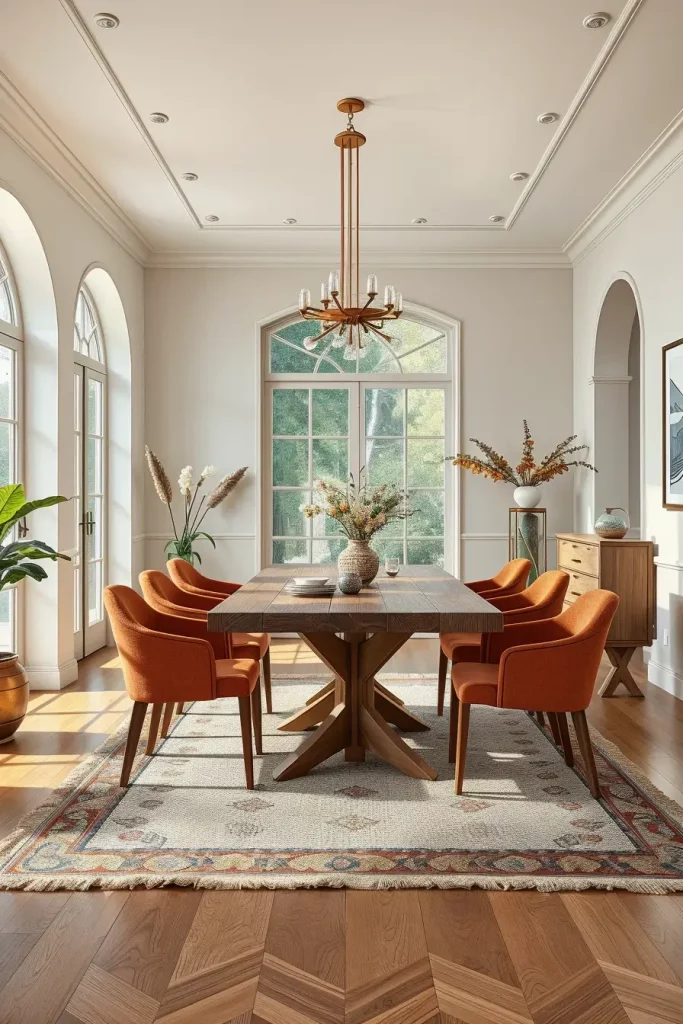
For me, adding upholstery is one of the simplest strategies for decorating with the seasons without making things cluttered. HGTV designers suggest using seasonal slipcovers for a quick and affordable solution and I usually recommend this to clients on a budget.
Should space allow, I’d add a bench with upholstered fabric that goes with the room’s other materials. It gives a feeling of softness and it lets you use more than one familiar texture in a single color grouping.
Using Neutral Wallpapers with Subtle Texture
Wallpaper is becoming popular again, especially among people who wish to bring depth and individual style to their dining room. When decorating late summer spaces, grasscloth, linen weave wallpaper or a peaceful cream or dove gray geometric print could be ideal. They give visual appeal and also maintain an air of peace and openness.
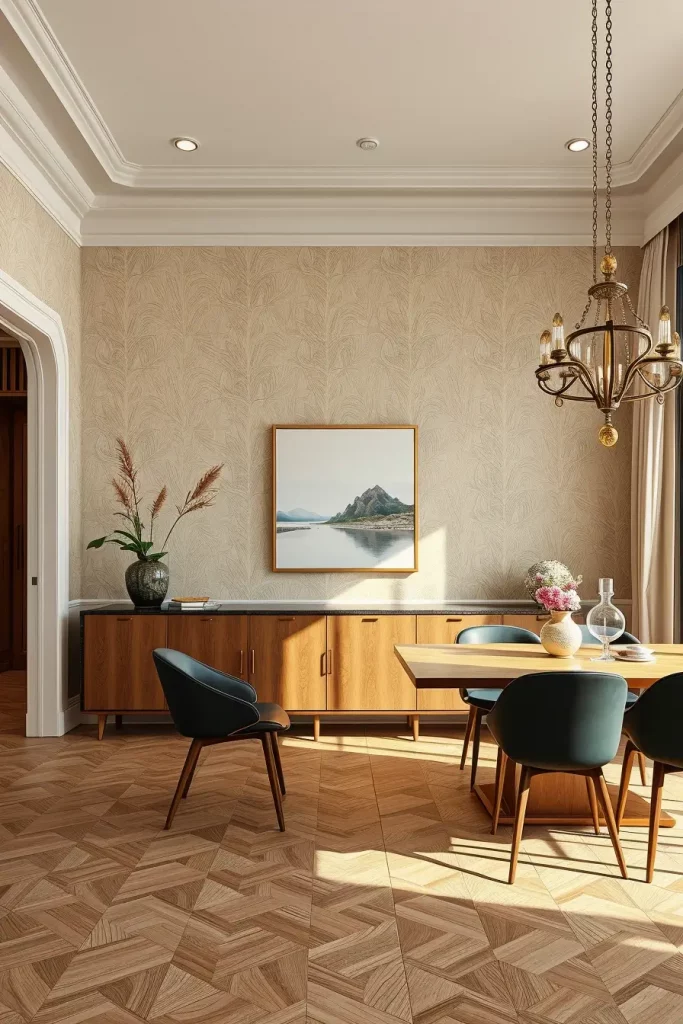
For the design of a dining space, I usually opt for texture on one of the walls using wallpaper. You might have it sitting against a wall or serving as the contrast to a set of simple artworks. Because the texture is soft, it makes the walls shimmer, including more detail in the room without stealing the spotlight.
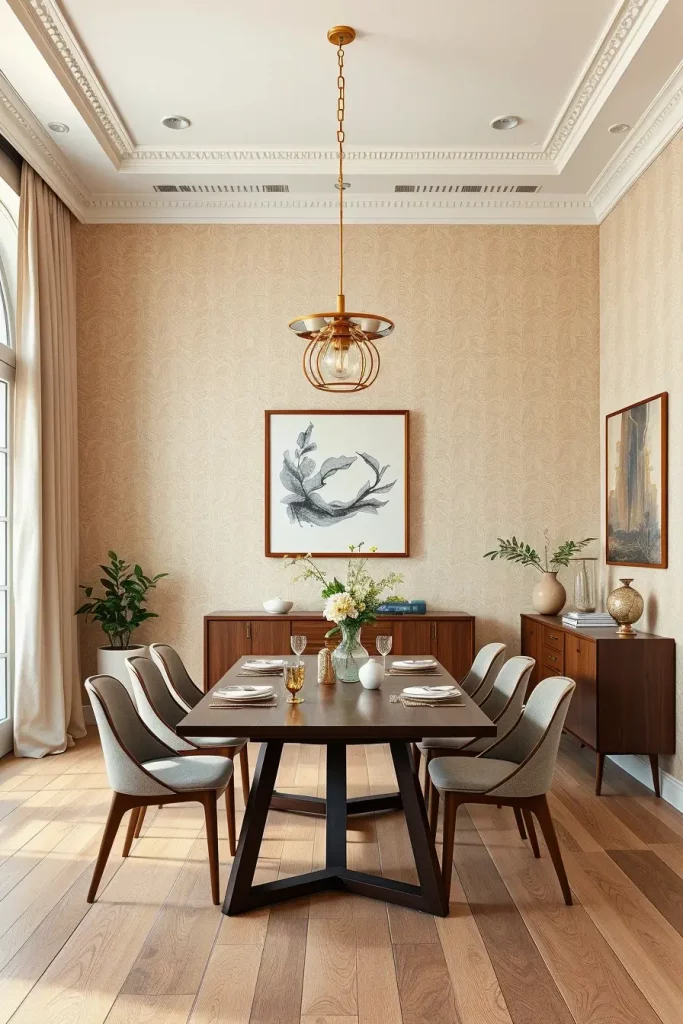
From a design perspective, texture also plays a larger role than color by itself. Elle Decor says that because of their versatile nature, textured neutrals make it easier for you to switch out seasonal accents, as I usually recommend to my clients.
If you want to make your room feel enclosed, you can place wallpaper on the ceiling as well. This element catches you off guard and enhances the atmosphere of the room.
Late Summer DIY Decor Ideas for a Personal Touch
Making your own decor with a personal touch is charming and it shows the transient charm of late summer. I suggest that clients make simple touches such as painting mason jars, making holiday garlands or dying table linens. These details make any dining place more unique and welcoming.

I love making a hanging bundle where rosemary, lavender and sage are the main herbs. Besides being lovely to look at, it gives off a pleasant scent that relaxes the air in the room. If you want to decorate your table, try coating terracotta coasters with paint or stamping leaves on napkins since this takes little effort and looks nice.
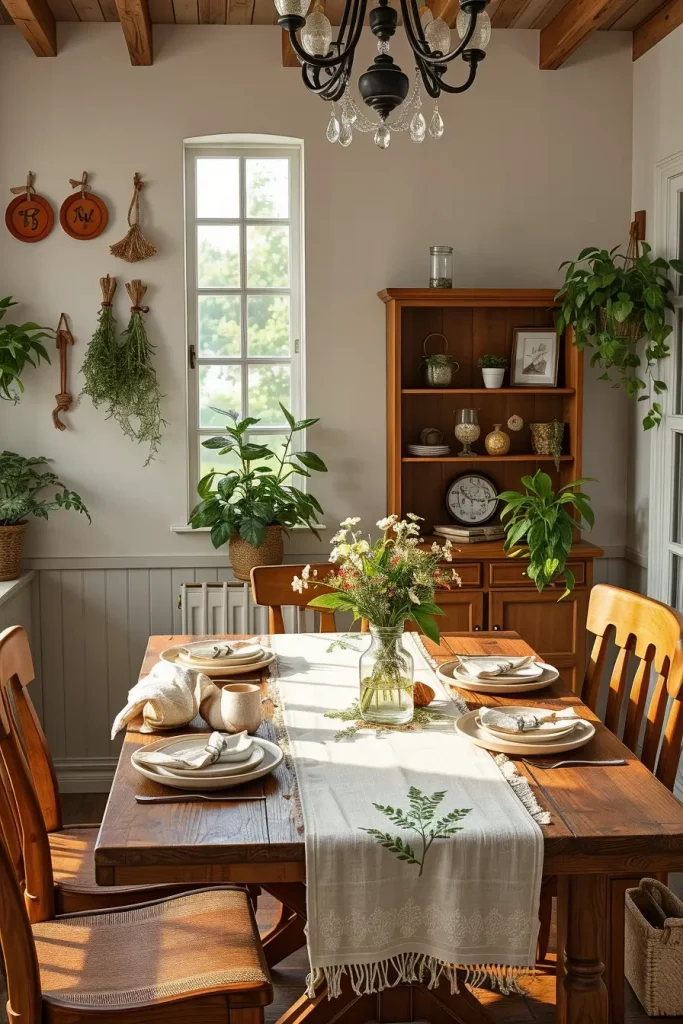
These personal touches tend to start conversation and help people feel more involved with the place. I’ve noticed that Better Homes & Gardens encourages readers to try seasonal DIY projects and I personally notice how these projects improve your home and its atmosphere.
Make this setup more helpful by including things you can reuse, for example, beeswax wraps and napkin rings from twine and dried flowers. These touches cut down on waste at the same time as adding unique beauty.
Mason Jar Arrangements with Seasonal Flowers
Mason jars never go out of style, so I usually use them as vases for changing seasonal flower arrangements. Late summer is the time when dahlias, sunflowers, cosmos and zinnias are looking their best. You can use these blooms to add lively, yet home-like, beauty to your casual or mid-range formal dinners.
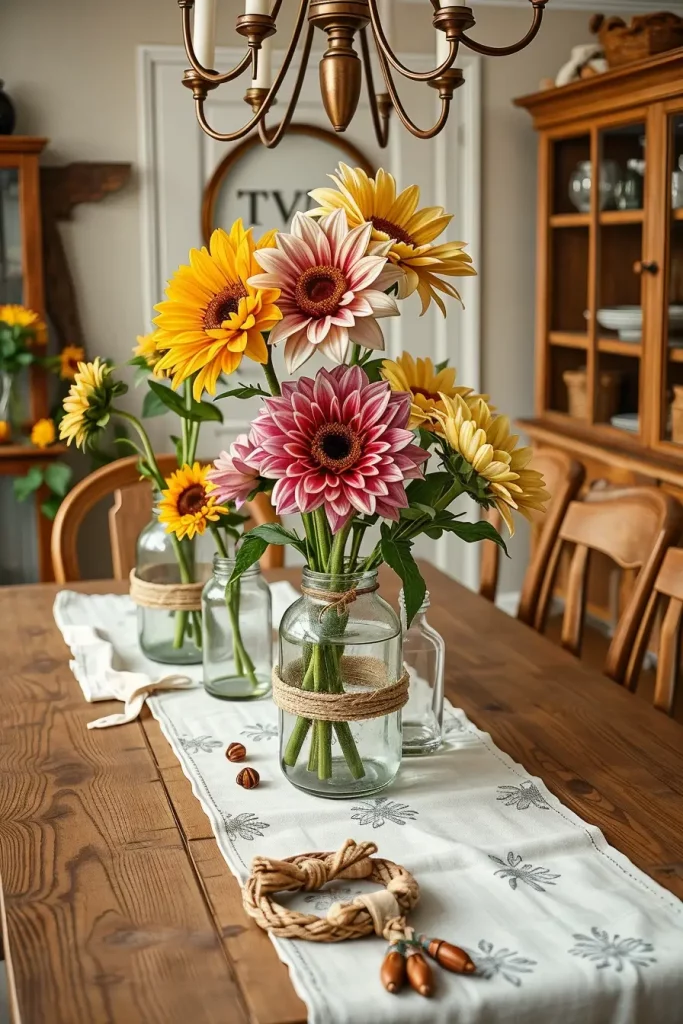
I prefer choosing different jar sizes to build up a step-like table arrangement. Secure the canes with twine or paint them in tones that go well with your table surroundings. Put the jars together in odd numbers along the table or place one at each guest’s seat for an adorable look.
This style always comes together in a believable way. In decorating seasons, Country Living often points out how well mason jars can be used because they are both simple and eye-catching.
Adding some basil or mint in the arrangement gives it a better look and warmly perfumes the air, making the meal even more enjoyable.
Transitional Decor Tips for Moving Into Fall
Since autumn is approaching, using transitional decor will help you update your interior without a big change. Start by replacing cotton tablecloths with thick linen and change out your summer centerpieces for greens and earth colors or dried flowers.
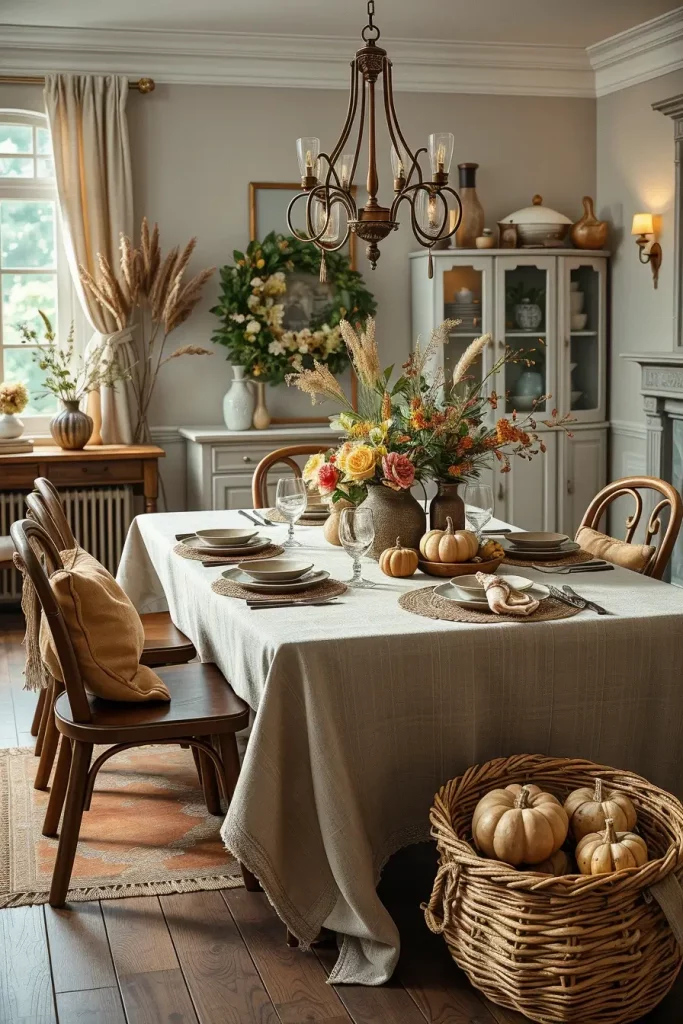
You could improve the ambiance by adding throws to chairs, introducing leather items such as placemats and coasters and using warmer light bulbs. A basket made of woven material and filled with gourds allows you to change seasons without strongly highlighting it. Adding little changes makes it easier for your late summer home to fit with fall as well.
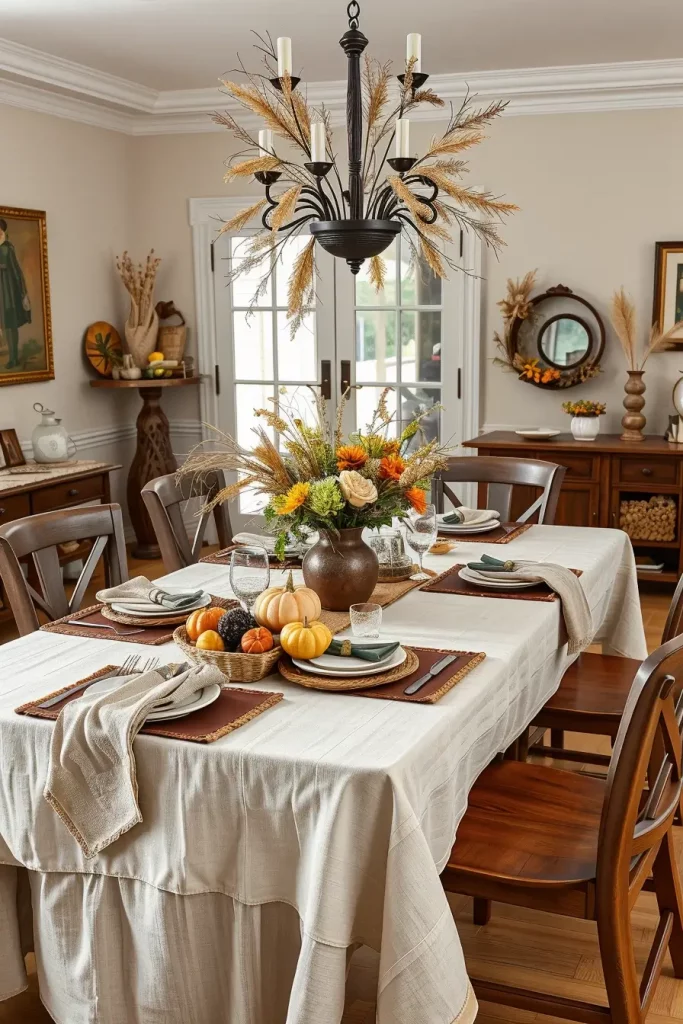
I support this way of thinking in professional settings. Southern Living suggests that it’s best to take your time adding touches of coziness and I can confirm this from my own experience.
One suggestion would be to switch sheer drapes for heavier ones like linen or cotton blend to bring in softness while still feeling warm.
Natural Fiber Rugs Under the Dining Table
Set the room for the late summer with a rug made of natural fiber put under the dining table. Because of their texture, woven rugs can add a pleasing warm feeling to any room; just make sure they are made of jute, sisal or seagrass so they don’t become too noticeable. They work well with any interiors, whether they are contemporary or traditional. Since autumn is often about earthy design, this rug can clearly mark out the eating area, whether the space is open or not.

Before picking a rug, I assess both the materials and the way it is made. A densely made sisal rug is suited for active dining rooms and a thicker jute rug gives the room a soft and natural feel. I believe that placing these with wooden dining sets made of oak or walnut enhances the difference between the smooth surfaces and textured flooring. A rug that’s large enough to keep all chair legs on it when pulled out is essential for cohesion and comfort.
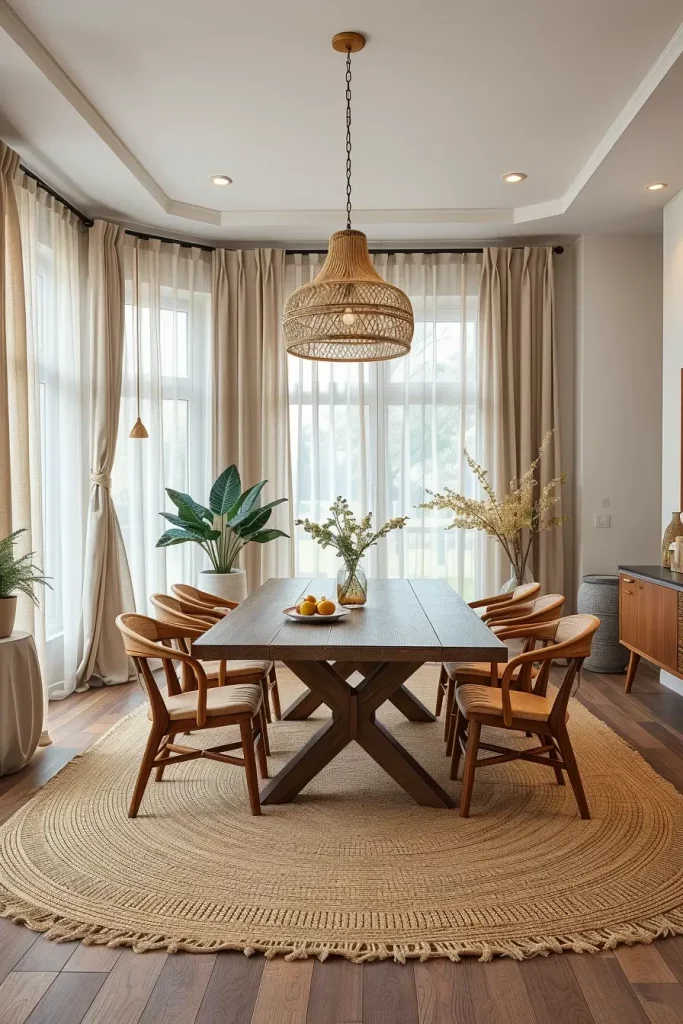
Based on my experience, people are pleased that these rugs allow for simple decoration changes rather than large-scale changes. Elle Decor states that covering a large floor with a natural rug reduces the echo which is useful for entertaining. A light accent might be made with a rug showing only a narrow colored border such as sage or terracotta.
To improve this style, I suggest placing light and translucent curtains that match the pattern of the carpet. A hanging light in rattan or linen right above the table can bring the design together and keep the atmosphere at ease.
Dried Floral Wreaths and Garlands for Dining Room Walls
When florals are turned into dried wreaths or garlands, it shows how the seasons move from bloom to the time for gathering. I usually select these pieces to make my walls look full, but in a manner that is still seasonal and well-designed. Mounting a set above a buffet or adding them above a dining room mirror helps add subtle color differences while not looking overly bright, like the main table arrangement.

Dried lavender, eucalyptus and strawflowers are the materials I like to use most. They are a great fit for summer since they come in gentle colors and retain their shape for a long time. Especially for a farmhouse style, try a mix of wheel-thin dried oranges or lemons and wheat for garlands hung playfully on open shelves or the edge of a sideboard. Having both linens and flax present on the table gives the room a cozy and collected atmosphere.
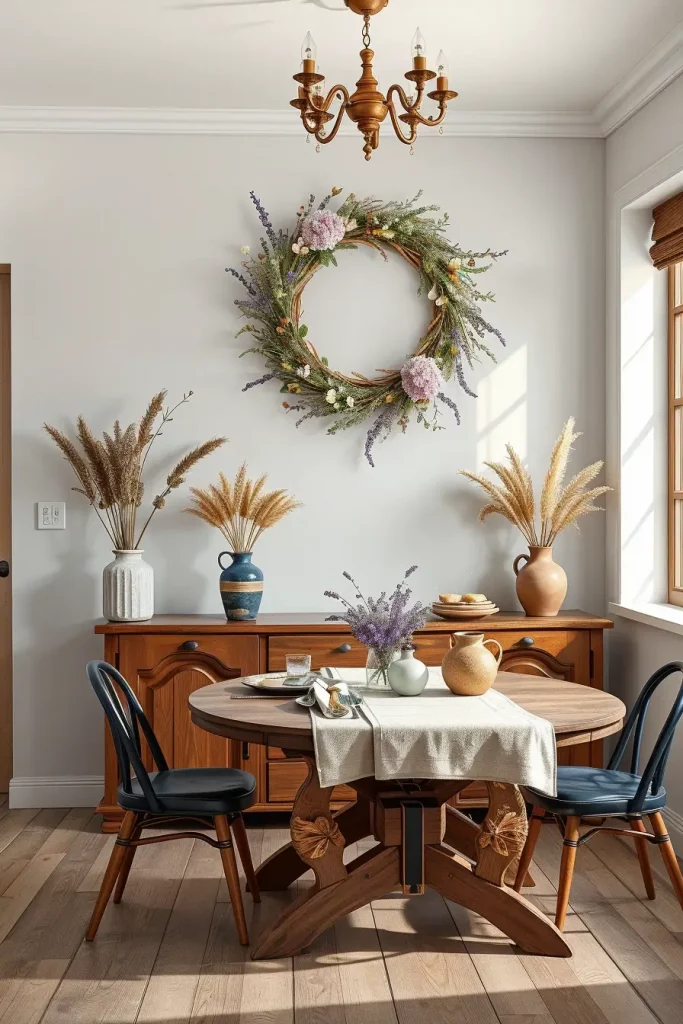
I often use a wreath in gallery-style arrangements with photos and mirrors. All together, they provide excellent balance to the composition. Better Homes & Gardens explains that, because dried flowers are low maintenance, you won’t have to replace them as often as simple fresh ones.
If you choose to add more to this decor, consider getting matching napkin rings and table runners with matching dried flowers. Putting pillar candles in gentle and neutral colors beside the arrangements reflects the charm by creating a warm glow.
Incorporating Sustainable and Eco-Friendly Decor Choices
Being aware of our shopping habits, it makes sense to style our late summer dining rooms using eco-friendly decor ideas. Usually, I begin my designs with materials that are good for the environment: recycled wood for furniture, bamboo lights or vintage glasses that are useful and tie my artwork to history. These choices enhance the space and follow an approach that benefits the environment in the long run.
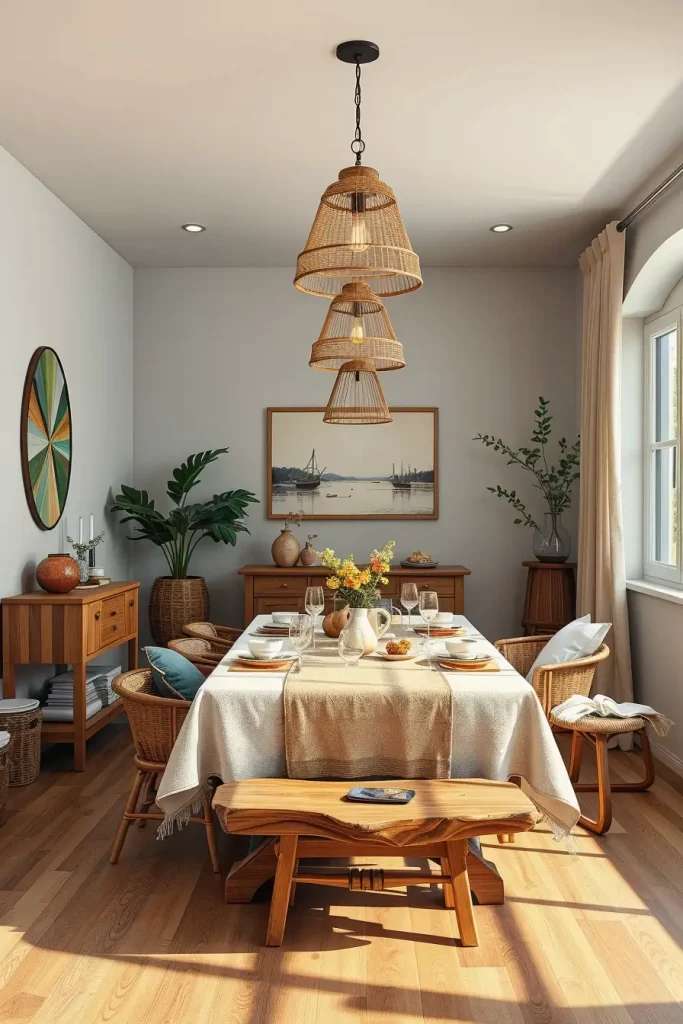
I like to use organic cotton or linen as my choice of tablecloths, placemats and napkins. Feeling and wearing these materials is comfortable, especially when they’re in the colors sand, stone or golden wheat which highlight the beauty of late summer evenings. Choosing LED light bulbs with a warm white shade placed inside attractive shades makes the space both comfortable and friendly to the planet.

Introducing sustainable ideas has led me to discover interesting decor products with personal stories and history. It is suggested by Architectural Digest to include handmade ceramics created by locals to make the environment more welcoming and friendly to the surroundings.
I would like to suggest making a live edge wooden bench to one side of the dining table. Combining this kind of stunning elements with unmatched previous-use chairs is both natural and kind to the environment.
Final Styling Tips for a Cohesive Late Summer Dining Room
It’s important to mix and match textures, colors and lighting to make the dining room feel pulled together. I normally add a natural rug to anchor the space and then add colors in different tones such as mustard, dusty red and shades of green. A vertical element such as wall art or a wreath goes well with a centerpiece created by candles or a small vase.

You should pay just as much attention to choosing your furniture. For a nice harmony, use the same type of wood in all your cabinets and shelves if your chairs are dark walnut. Decking your chairs with neutral colored slips is an easy way to bring different styles together. Tools like textured glassware, woven napkin rings or stoneware plates allow you to give your dining table a classic look.
In my projects, I tend to use one material such as wood or ceramic all the way through to link the various features of the place. House Beautiful suggests using layered lighting (pendants, candles, and ambient floor lamps) to add depth and dimension to your dining room, especially during transitional seasons.
The one thing I’d suggest for extra warmth is a vase filled with foraged twigs or potted herbs. They add a fresh look that follows the style of your home and helps move from summer to autumn happily.
A good way to change your dining area for the late summer is to add touches that are both stylish and reflect the bright and fun feelings of late summer. Infusing natural materials and choosing eco-friendly items contributes to the feeling of the room. I’d love to hear how you’ve styled your dining room this season—share your ideas or questions in the comments below!
